INTRODUCTION
Batman Begins primarily reflects the early years of the Post-Crisis Batman's career, taking many of its cues from Frank Miller and David Mazzucchelli's Batman: Year One (1987) and the first few story arcs published in Legends of the Dark Knight Volume 1 (1989-2007).
Responsibility for ensuring adherence to the comics fell largely upon David Goyer, who co-wrote the script with Christopher Nolan.
"Chris had never read comic books. He didn't know the world. So he trusted me on that franchise and with Superman to know what was canon: what could be changed and what couldn't be changed."
A few of Goyer’s comic influences were listed in a 2004 MTV article:
Goyer knew immediately which Batmans he wanted to reference. Consider it his Batman canon: Frank Miller’s noir take on Batman’s early career in “Year One,” Jeph Loeb’s “The Long Halloween” and its sequel, “Dark Victory” (which was written with Tim Sale), and Denny O’Neil and Neal Adams’ 1970s work, which introduced the villain Ra’s al Ghul.
‘The Man Who Falls’ (Secret Origins of the World’s Greatest Super-Heroes, 1989) was cited as a structural influence on the film during the Genesis of the Bat DVD documentary. This story was reprinted in the Batman Begins tie-in graphic novel which was included with the DVD release, along with the first chapter of Jeph Loeb and Tim Sale’s Batman: The Long Halloween (1996-1997).
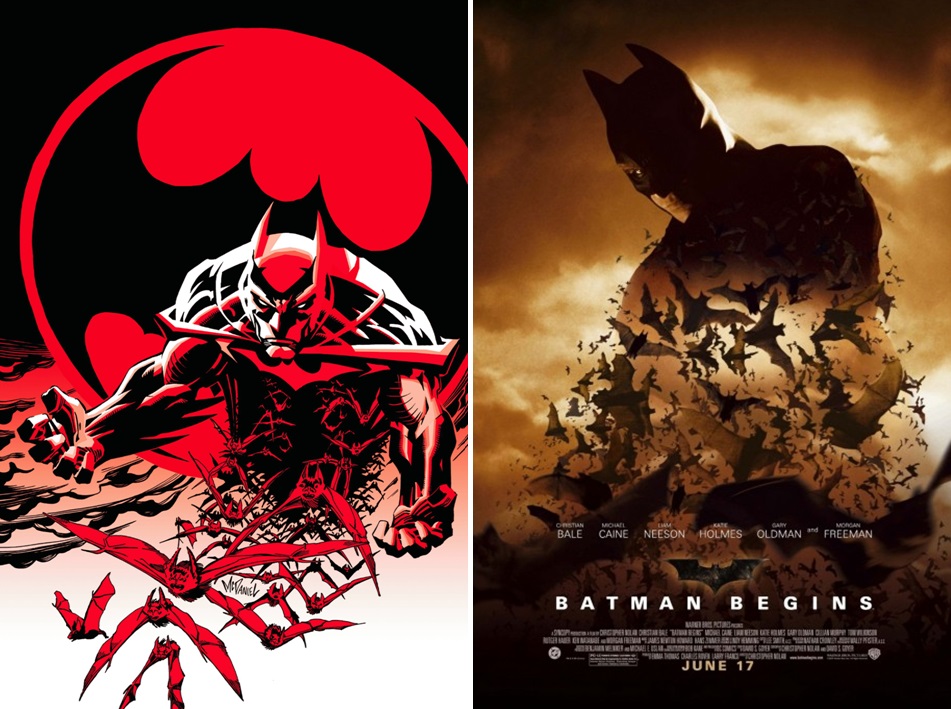
Did Scott McDaniel’s cover art for Batman Vol 1 #600 (April 2002) inspire the poster?
The following analysis highlights the numerous similarities between Nolan’s first Batman film and the comics that inspired it. Many of these elements were consciously adapted from the source material, while other parallels are more likely coincidental. But whether they were deliberate or not, we’re noting as many as we can find.
The swarm of bats during the opening scene might have been inspired by Year One.
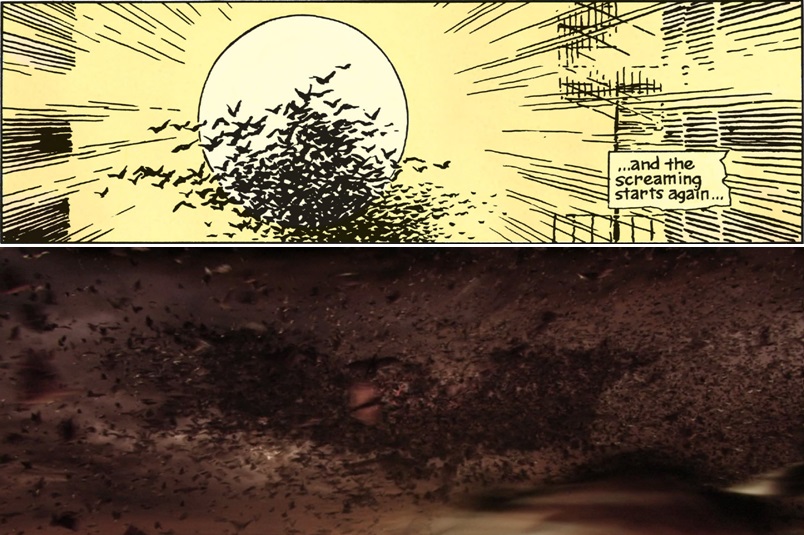
The film begins with a flashback showing the young Bruce Wayne (Gus Lewis) falling into a cave and being overwhelmed by his fear of bats. This scene was first depicted in Frank Miller and Klaus Janson's Batman: The Dark Knight Returns (1986). However, the movie version more closely resembles the retelling of this scene from 'The Man Who Falls'. Here, Bruce falls into the cave after stepping on some wooden boards which collapse under his weight.

As he lies on the floor of the cave a swarm of bats emerges from the darkness to envelop him.
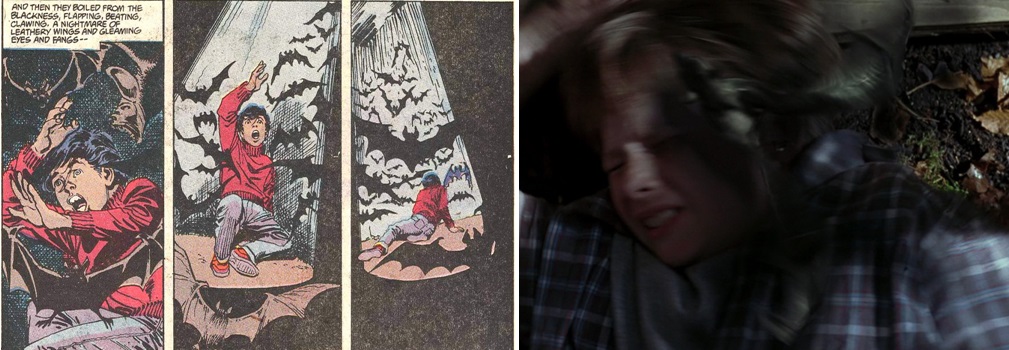
Fortunately his father, Thomas Wayne, comes to his rescue.
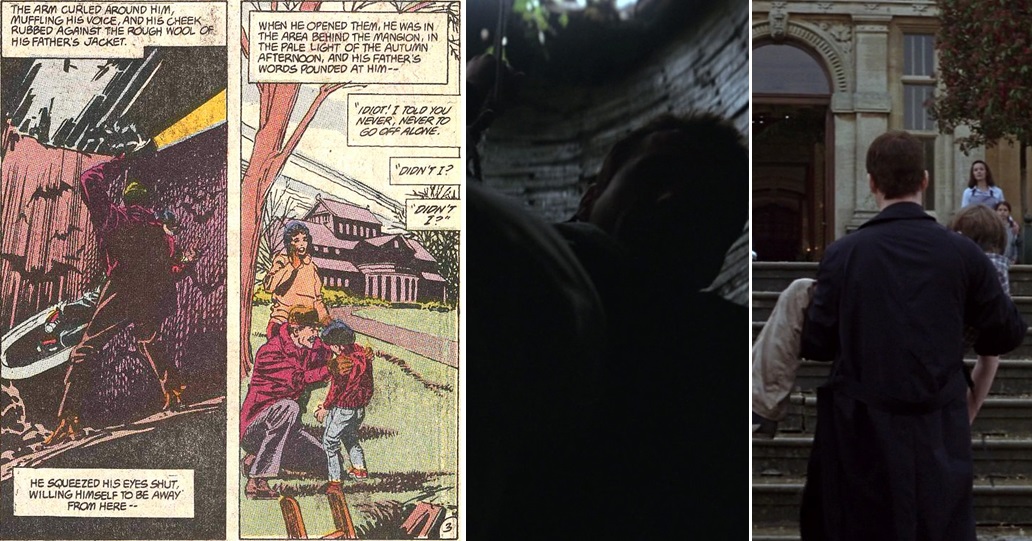
The scene in which Bruce’s parents are murdered is faithful to the comics, with the one deviation being that the Waynes are shown going to the opera instead of the cinema. In the story arc Hush, Bruce briefly mentions that his father was a fan of opera.
As in the comics, the killer is a lowlife named Joe Chill, played here by Richard Brake.

Thomas and Martha are played by Linus Roache and Sara Stewart respectively. Both of these characters debuted in ‘The Batman Wars Against the Dirigible of Doom’ (Detective Comics Vol 1 #33, November 1939). As in the comics, Thomas is portrayed as a successful doctor and humanitarian committed to improving the quality of life for the people of Gotham.
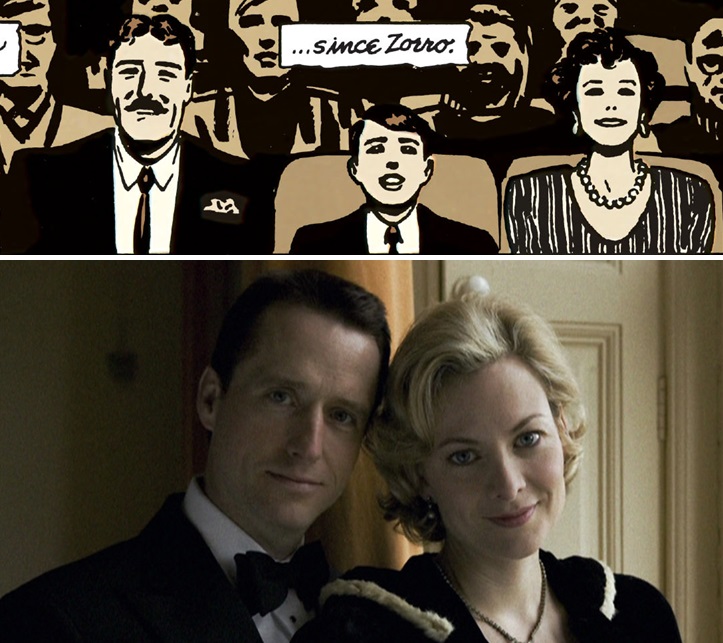
Chill accosts the Waynes at gunpoint in Crime Alley and robs them. The detail of having Chill grab Martha’s pearl necklace is a nod to The Dark Knight Returns.
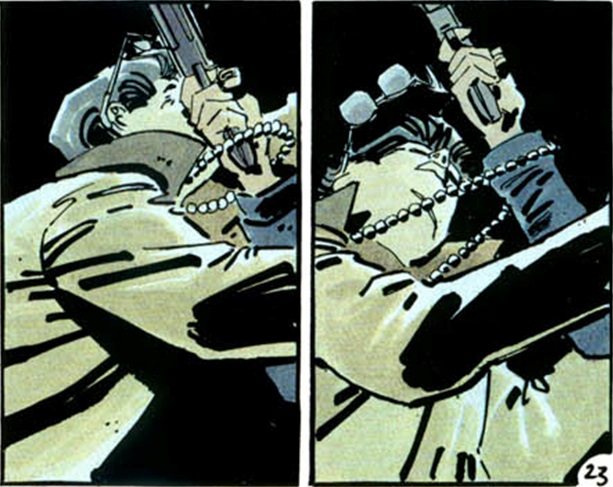
The image of the young Bruce kneeling over his parents’ corpses in Crime Alley is taken straight from Batman: Year One.

Alfred, the trusted Wayne family butler, comforts Bruce during the funeral.

Alfred, played here by Michael Caine, first appeared in the comics back in ‘Here Comes Alfred’ (Batman Vol 1 #16, April 1943).
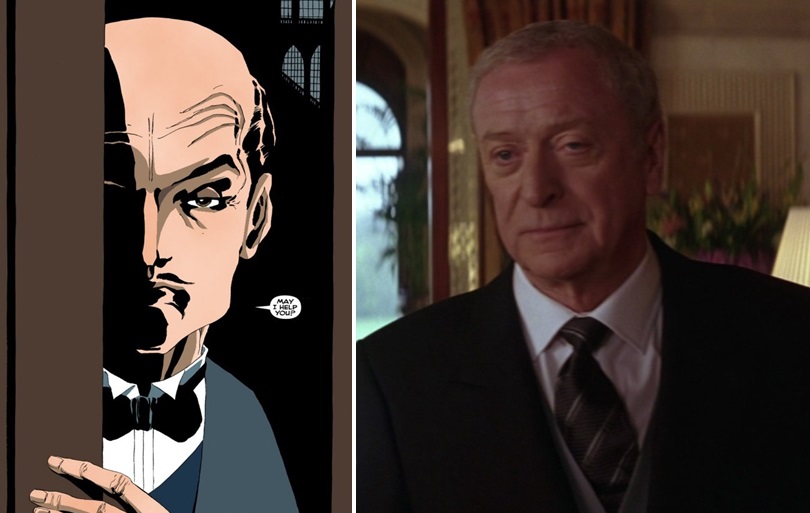
Christian Bale presents a strong physical match for the comic book Batman. Standing 6'0 tall, he's only 2 inches shy of Bruce Wayne's height in the comics. He also built up a muscular physique for the role that accurately reflects the build of the comic book Batman. Bruce Wayne weighs 210 lbs in the comics, while Bale's weight was around 190 lbs during the filming of Batman Begins.
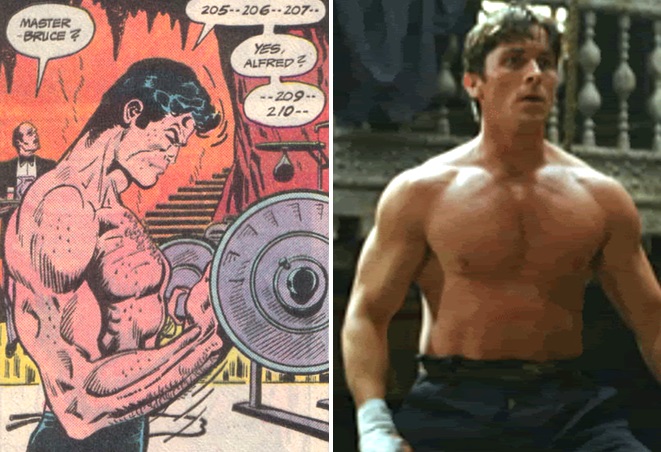
Bale's facial features are also well suited to the character. You could nitpick that his eyes are brown instead of blue, but several notable artists have also depicted him with brown eyes in the comics. The following example is from Batman: Year One.

The scene where Bruce returns to Wayne Manor and informs Alfred he's back for good seems to have been influenced by a similar moment in Batman: Shaman (1989-90).
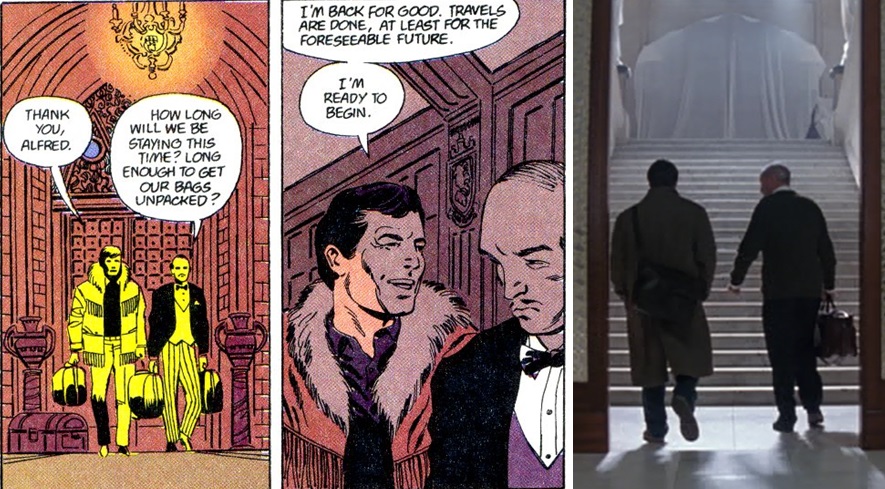
The look of the main hall, filled with statues and furniture draped in white sheets, recalls the appearance of Wayne Manor when Bruce returned from his youthful travels in Batman: Gotham by Gaslight (1989).
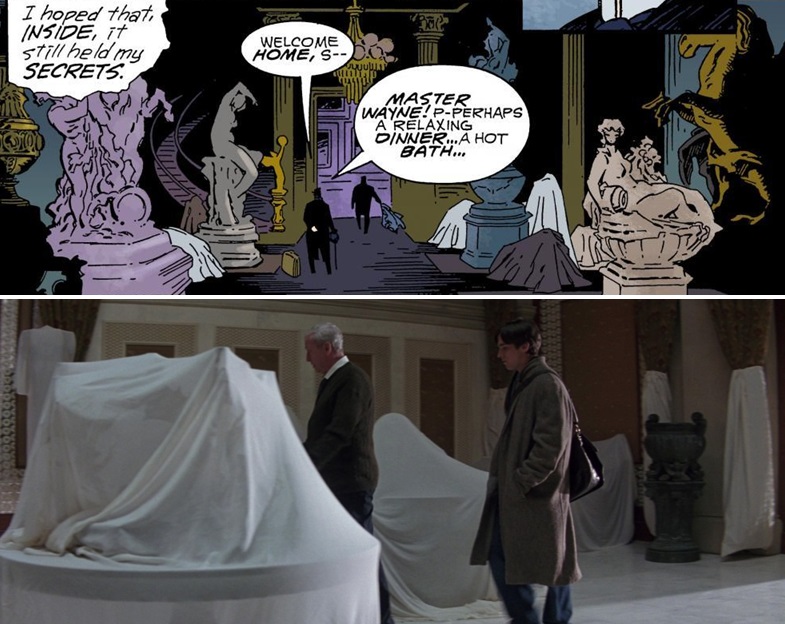
The sequence where Bruce plans to kill Joe Chill, only to be thwarted when someone else kills him first, is similar to the final chapter of Batman: Year Two (1987). In Year Two, Batman finally catches up with Joe Chill and plans to kill him using a handgun. However the Reaper murders Chill just as Batman is about to pull the trigger, denying him the satisfaction of the kill, just as Falcone’s assassin does in the movie.
Following the death of Joe Chill, we are introduced to Carmine Falcone himself, played by Tom Wilkinson. As in the comics, Falcone is the most powerful mob boss in Gotham. He first appeared in Batman: Year One and featured prominently in The Long Halloween.
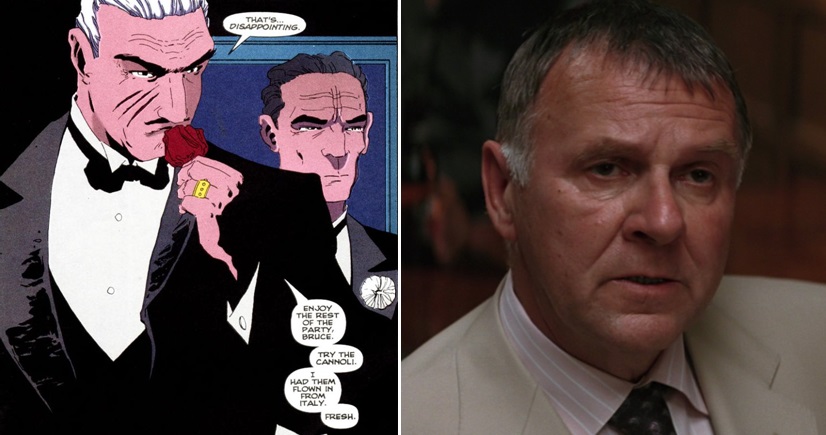
Bruce's wanderings have been depicted numerous times in the comics, usually in the form of flashbacks. ‘The Man Who Falls’ was essentially a narrative assembled from such flashbacks.
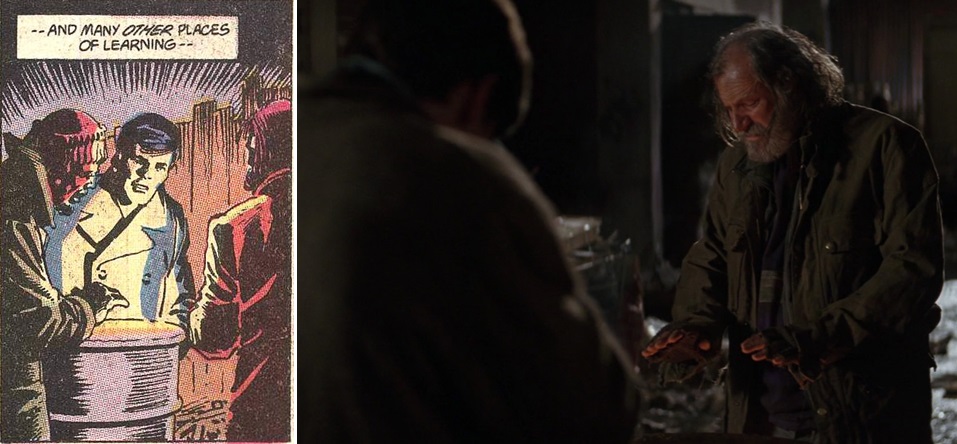
Bruce is depicted with a beard during his time in Asia. This reflects how he looked during his pre-Batman travels in 'The Man Who Falls'.
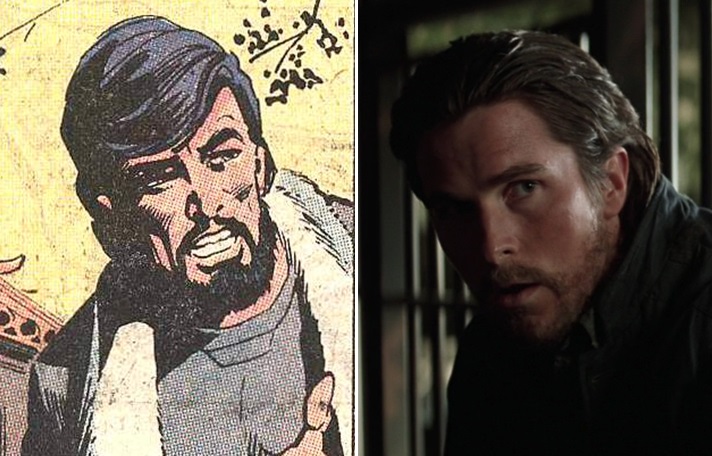
A scene common to many of these stories is that of the young Bruce climbing a mountain in some remote part of Asia. Upon reaching its summit, he enters the house of his would-be master and finds them seated, waiting for him. One example would be when he trained with Chu Chin Li in Sam Hamm’s Batman: Blind Justice (Detective Comics Vol 1 #598-600 March–May 1989).
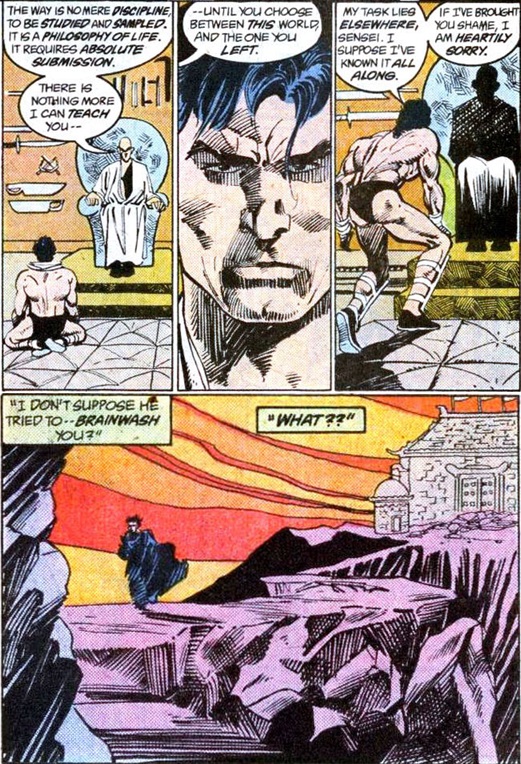
And again when he sought out Shao-la in 'Tao' (Legends of the Dark Knight #52-53, October 1993).
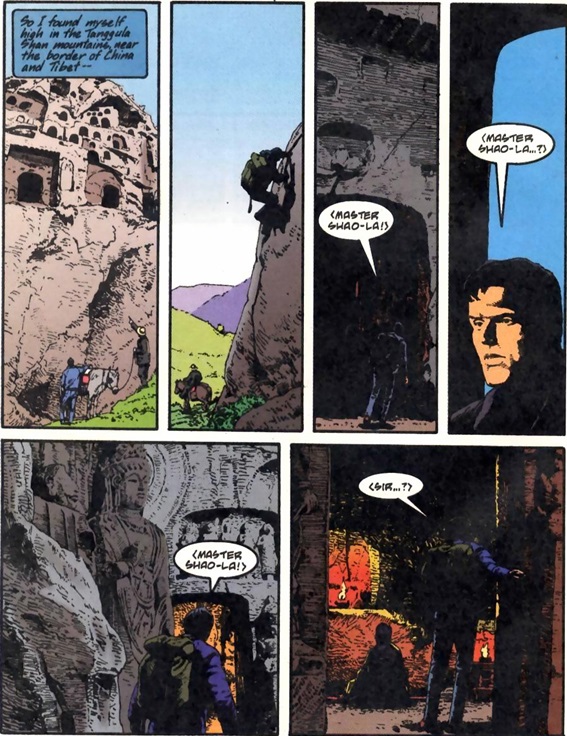
But in the movie Bruce’s principal mentor is Henri Ducard. Ducard made his first appearance in Batman: Blind Justice and also featured in ‘The Man Who Falls’. He was a European vigilante and ‘trouble-shooter’ who took the young Bruce Wayne under his wing. In the film he’s played by Liam Neeson. In both the comics and the film, Ducard recognizes Bruce's exceptional fighting skills upon first meeting him. He has no qualms about executing criminals and easily deduces it is his former student beneath Batman's cape and cowl when the latter begins his operations in Gotham.
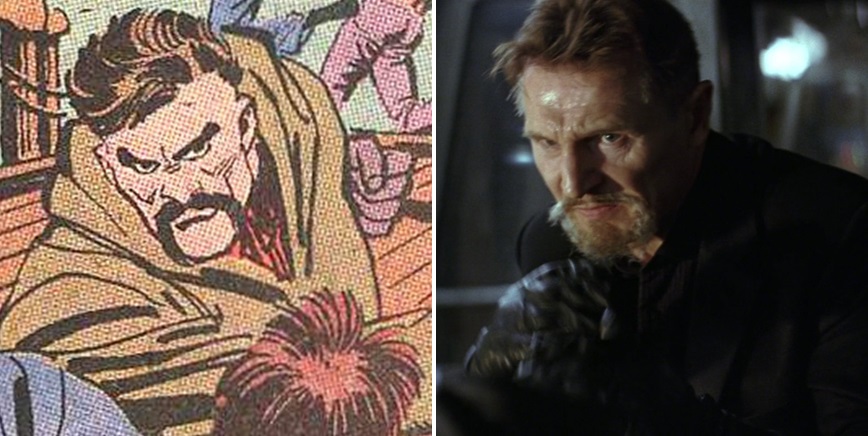
Bruce's arrival at the League of Shadows' headquarters is visually similar to his arrival at Kirigi's house in 'The Wall' (Batman Vol 1 #431, March 1989), a scene which was also depicted in ‘The Man Who Falls’. In both the comic and the film, these scenes are flashbacks showing Bruce arriving at the home of a master he hopes will train him. Kirigi, the ninja who trains Bruce in the comic, also taught members of the League of Assassins.
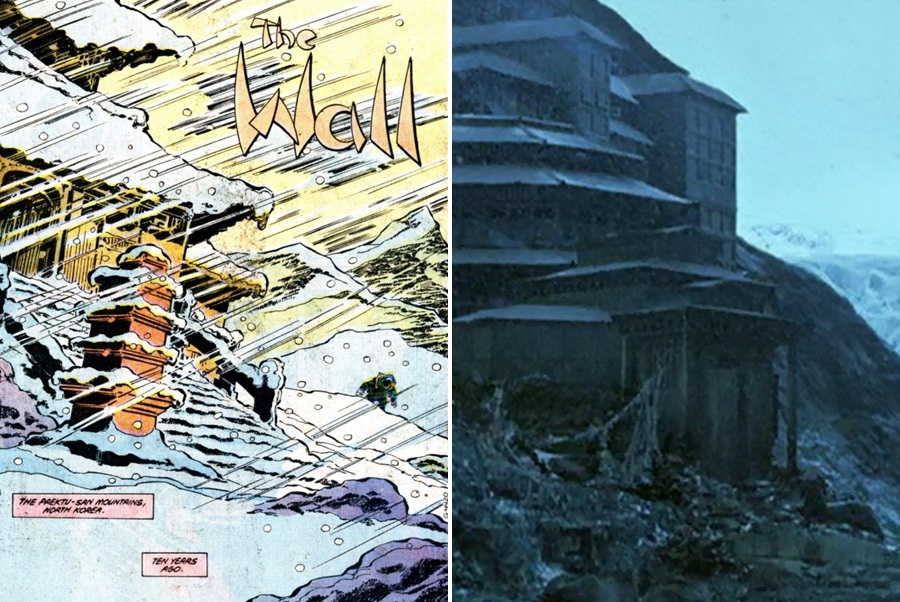
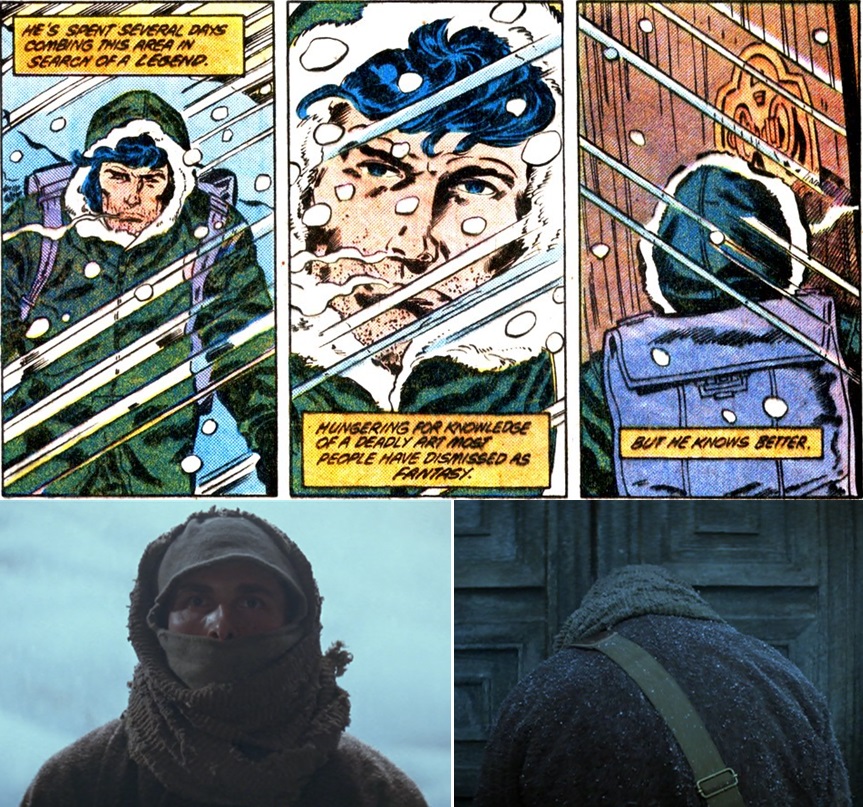
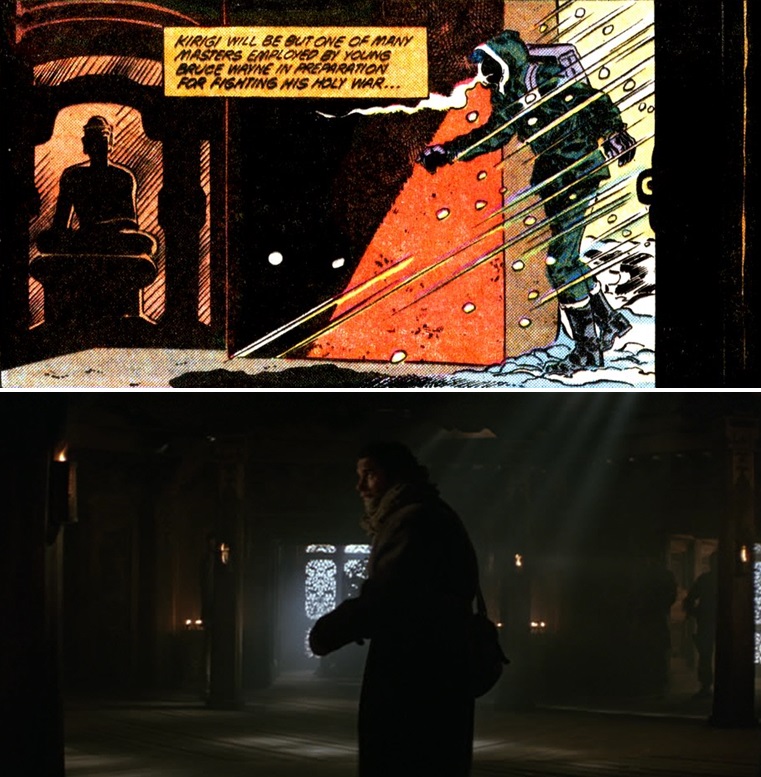
The League of Shadows is of course Nolan’s version of the League of Assassins, a criminal organisation that first appeared in ‘A New Lease on Death’ (Strange Adventures #215, December 1968). They made their debut in the Batman comics in ‘Daughter of the Demon’ (Batman Vol 1 #232, June 1971), the same story in which their leader Ra’s al Ghul first appeared. In the comics Ra’s is of Arabic descent, while in the movie he is played by Japanese actor Ken Watanabe.

It’s later revealed that Watanabe’s character is merely a decoy and Ducard himself is the real Ra’s al Ghul. As with Watanabe’s character, Neeson’s Ra’s is clearly not of the same ethnicity as the comic book Ra’s. However he does share one physical characteristic with the comic book character in so far as they are both 6’4.
The Ra’s in the comics executed a similar deception in Batman Vol 1 #232 where he faked his own death and presented a disguised Ubu as the leader of the League. Batman defeated and unmasked Ubu, then exposed the fact Ra’s was still alive. This all turned out to be part of an elaborate test to see if Bruce was worthy of succeeding Ra’s as the head of the League.
When Ra’s first approached Batman in the comics, he did so with the intention of having Bruce Wayne marry his daughter, Talia. Talia al Ghul would not appear in the Nolan Batman films until The Dark Knight Rises (2012), however Ducard does allude to having had a family in Batman Begins. Ra’s approaches Bruce in the movie with the aim of having him spearhead the League’s impending campaign against Gotham; a responsibility Bruce spurns, much like his comic book counterpart.
During his first comic book appearance, Ra’s had a hideout in the Himalayas not unlike the one in the film.
As part of his training Bruce practices sword fighting on a frozen lake with Ducard. Batman and Ra’s have duelled with swords many times in the comics.
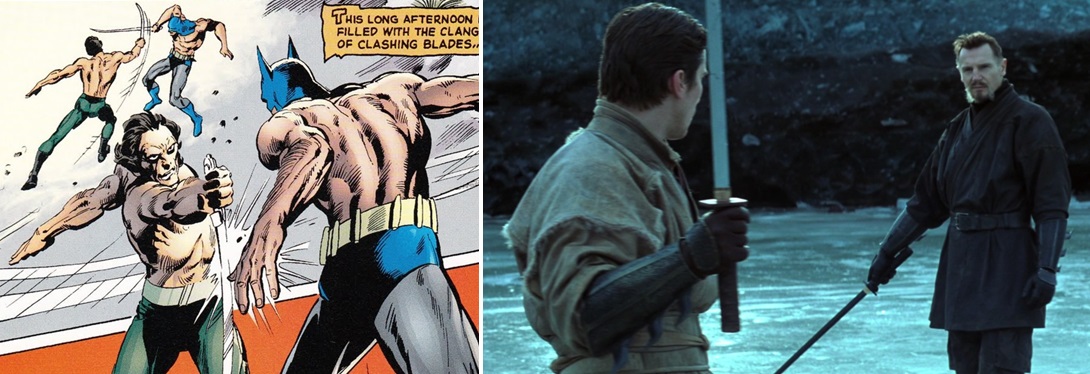
Bruce's training with the League of Shadows is somewhat similar to the retraining he undergoes during Batman: KnightsEnd (1994). In both stories he is tutored by a criminal (Ra's/Lady Shiva) in the ways of the ninja. One scene in particular is more or less identical to a scene from the comic, where Ra's instructs Bruce to execute a captive criminal.
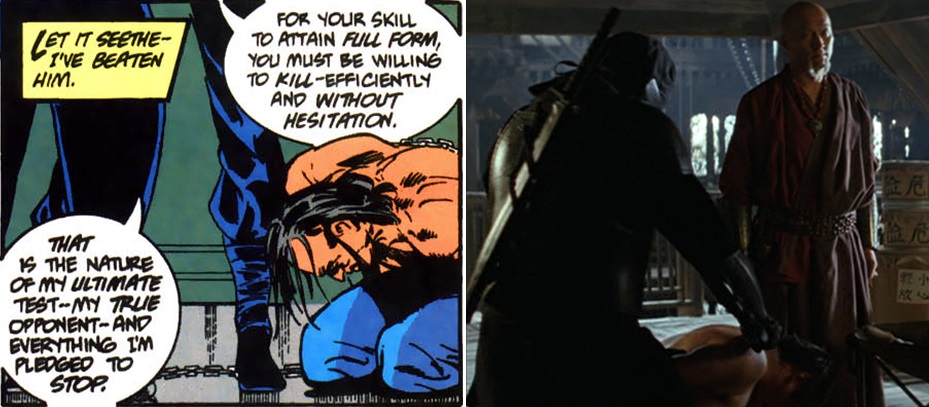
But of course Bruce refuses.
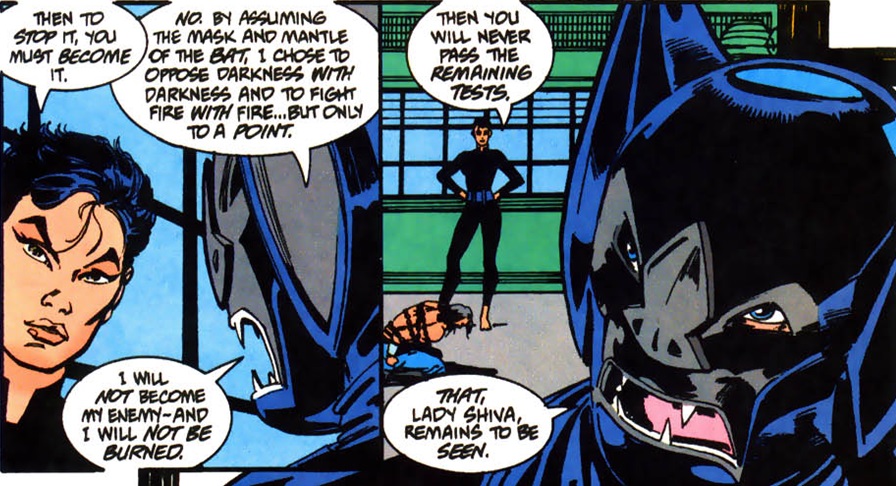
Bruce dissolved his alliance with Ducard over a similar moral disagreement in the comics. In the film, their impasse leads to a battle in which Bruce destroys the League of Shadows headquarters. This desperate act results in the death of at least one person, possibly more. The lethal consequences of Bruce’s inexperience here reflect a similarly fatal encounter he had with Tom Woodley in Batman: Shaman. In the comic, the young Bruce Wayne encounters Woodley during his pre-Batman wanderings and the two end up fighting on a snowy mountain. The fight ends with Bruce accidently knocking Woodley over the precipice and watching him plummet to his doom.
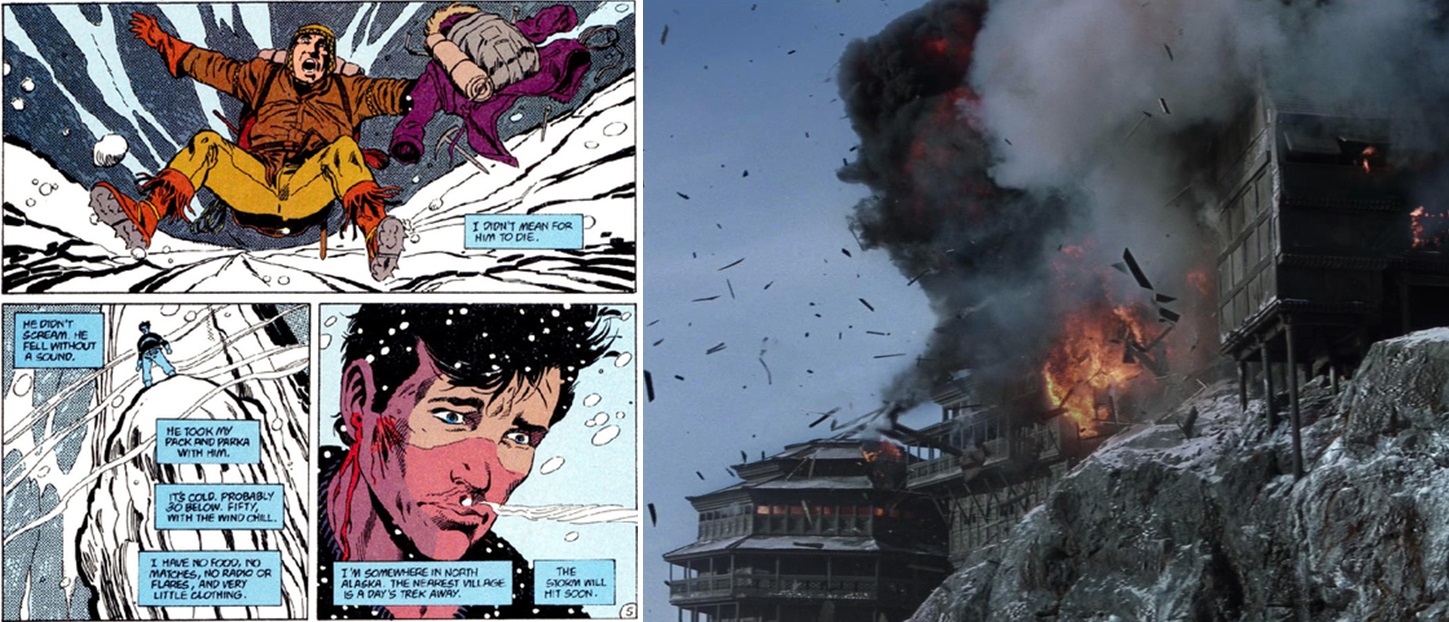
It’s later revealed that Woodley survived the fall, but for the moment Bruce believes his rookie mistake has cost the life of a human being. Woodley would subsequently travel to Gotham to avenge himself against Bruce, just as Ra’s does in the film.
Bruce flying back to Gotham after his travels recalls his first appearance in Batman: Year One.
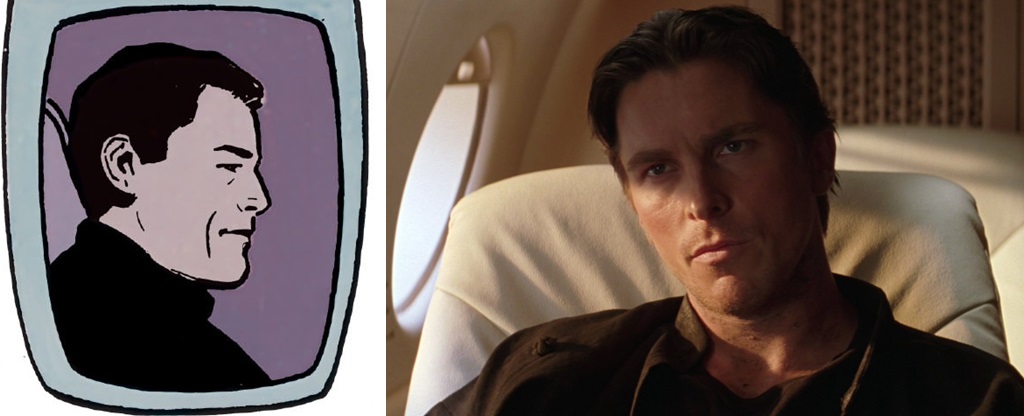
During the flight to Gotham, Bruce articulates his idea for adopting a disguise as an instrument of fear against criminals. His dialogue in this scene, where he talks about becoming a symbol, is very similar to his musings in The Untold Legend of the Batman (1980) where he says, “Maybe I’ve got to become more than a man... I’ve got to become a symbol!”
The depiction of Gotham City as a crime-ridden metropolis is faithful to the comics, and several landmarks from the source material feature prominently in the film. These include the Wayne Enterprises Tower.
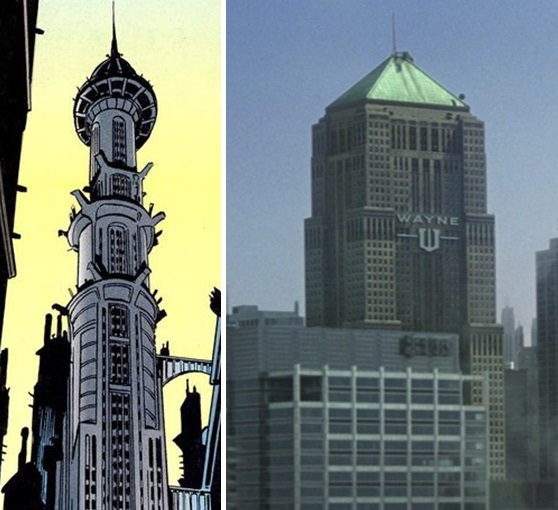
Gotham Narrows, which was first mentioned in ‘The Duo Defy’ (season 2 episode 60) episode of the sixties Batman TV show and was later incorporated into the comics in 'If a Man be Made of Clay' (Detective Comics Vol 1 #479, October 1978), where Batman confronted Clayface III/Preston Payne at the 'Gotham Narrows Bridge.'

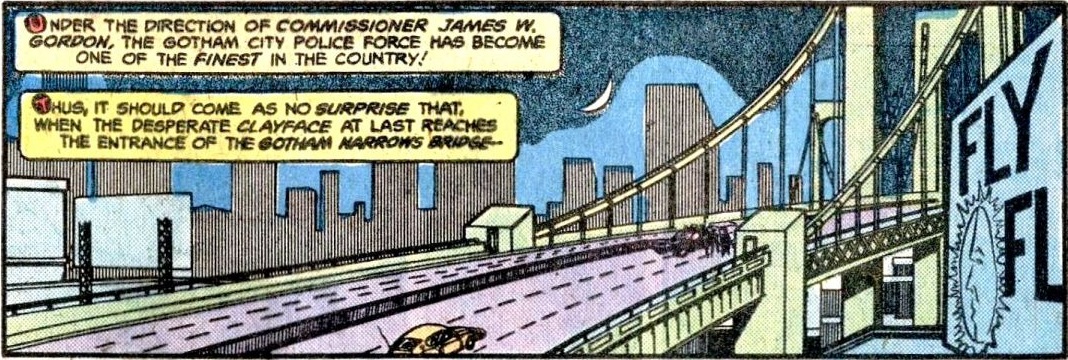
Arkham Asylum, which first appeared in ‘Threat of the Two-Headed Coin!’ (Batman Vol 1 #258, October 1974). Originally Arkham looked less like a mansion and more like an institutional building, much like the version in the film.
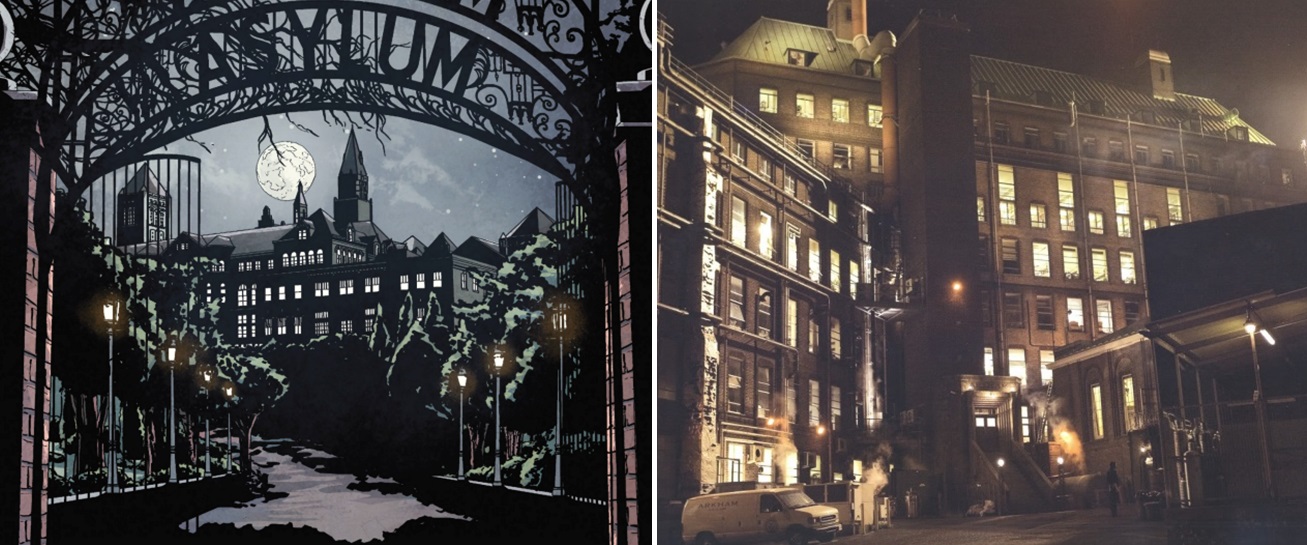
And of course stately Wayne Manor.

The Gotham monorail features prominently in the film, as it did in David Mazzucchelli’s artwork for Batman: Year One.

The scene where Bruce is sitting on the floor in Wayne Manor organising his files is another moment lifted from Batman: Shaman.
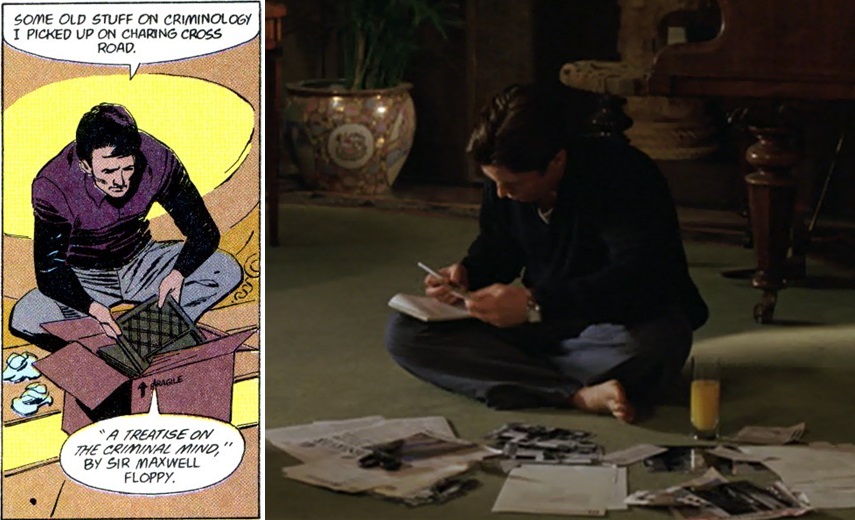
James Gordon was the only major Batman character besides Bruce Wayne himself to debut in Detective Comics #27 (May 1939). The version presented in this film, portrayed by Gary Oldman, is heavily based on the younger Year One incarnation and his subsequent appearances in the late eighties and early nineties.

Gordon’s partner in the film is Detective Arnold Flass, played by Mark Boone Junior. Flass made his first appearance in Batman: Year One, in which he was also portrayed as Gordon’s partner.
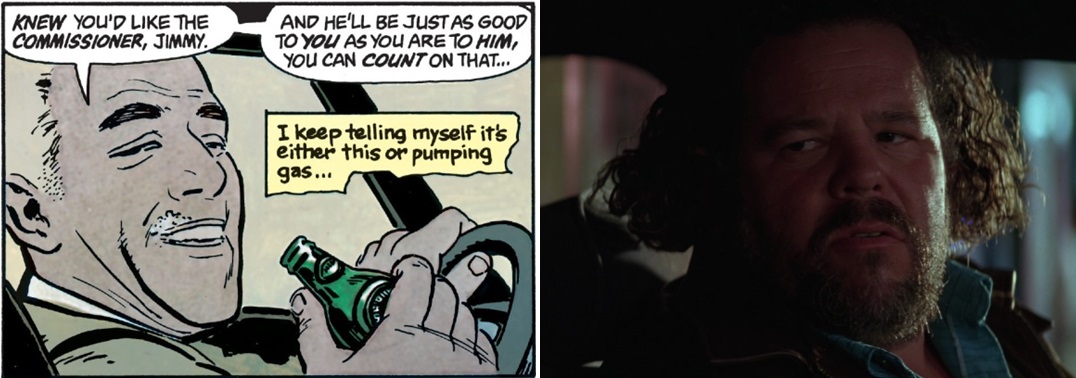
In both the comic and the film, Flass attempts to draw Gordon into the world of police corruption by encouraging him to accept dirty money. But Jim refuses to compromise his morals.
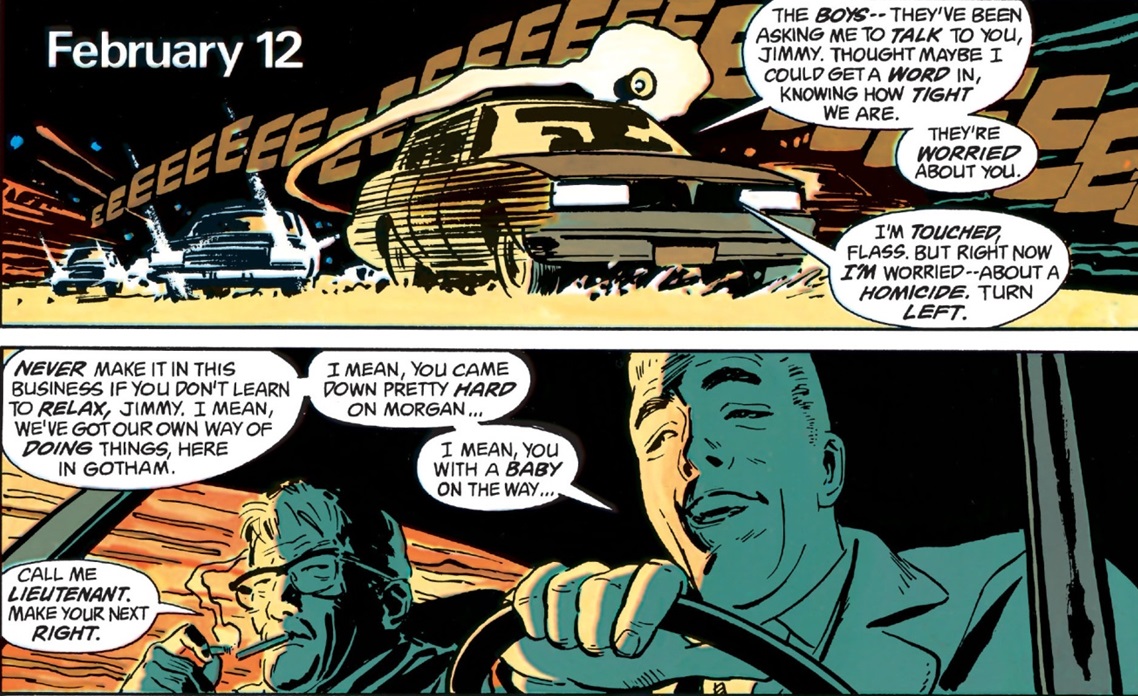
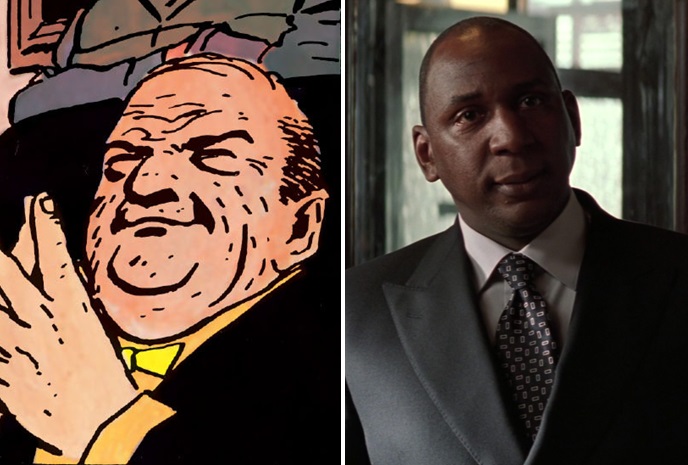 In one scene Gordon witnesses Flass stealing money from a street vendor but suppresses his disapproval. A similar scene occurs in Batman: Year One where he sees Flass assault a youth on a street corner.
In one scene Gordon witnesses Flass stealing money from a street vendor but suppresses his disapproval. A similar scene occurs in Batman: Year One where he sees Flass assault a youth on a street corner.
Colin McFarlane (right) portrays Commissioner Gillian B. Loeb, yet another character who made his debut in Batman: Year One. In the comics, Loeb was a thoroughly corrupt policeman who blackmailed Gordon and was fully cognizant of the numerous wrongdoings perpetrated by his officers. In the film, his involvement in the corruption is vague at best. Unlike his comic book counterpart, the live action Loeb is never explicitly shown to do anything outside his legal jurisdiction, suggesting he may in fact be an honest cop.
The scene where Bruce ventures into the cave and confronts his fear of bats may have been influenced by a similar scene from The Dark Knight Returns. In both stories, Bruce returns to the same part of the cave into which he fell as a child. There he faces the childhood terror that has since haunted him. But instead of running he stands his ground, conquering his fears and attaining spiritual oneness with his animal totem.
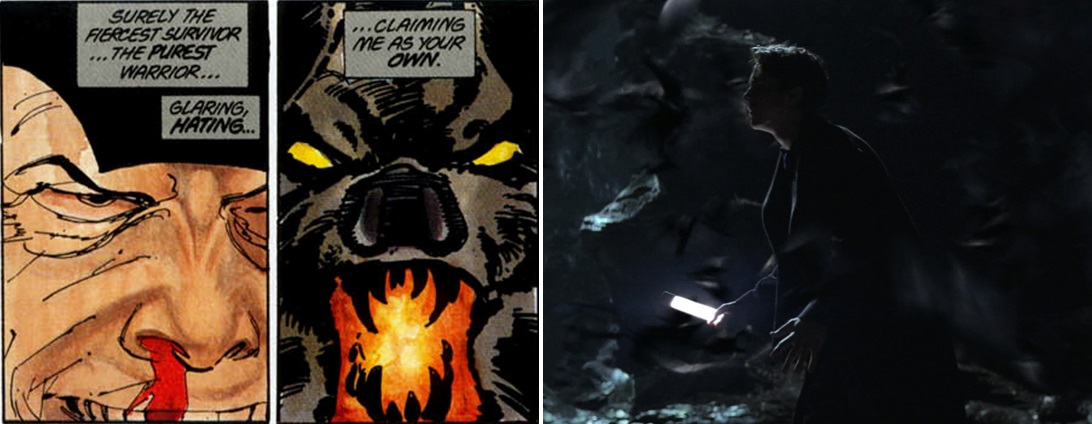
The moment serves the same narrative purpose as a scene in the 1939 origin, where Bruce saw a bat fly through the window and decided to adopt its image in order to terrify criminals.
The look of the Batcave, with the brick foundations of Wayne Manor clearly visible, is reminiscent of how artist Kelley Jones depicted it in Batman & Dracula: Red Rain (1991).
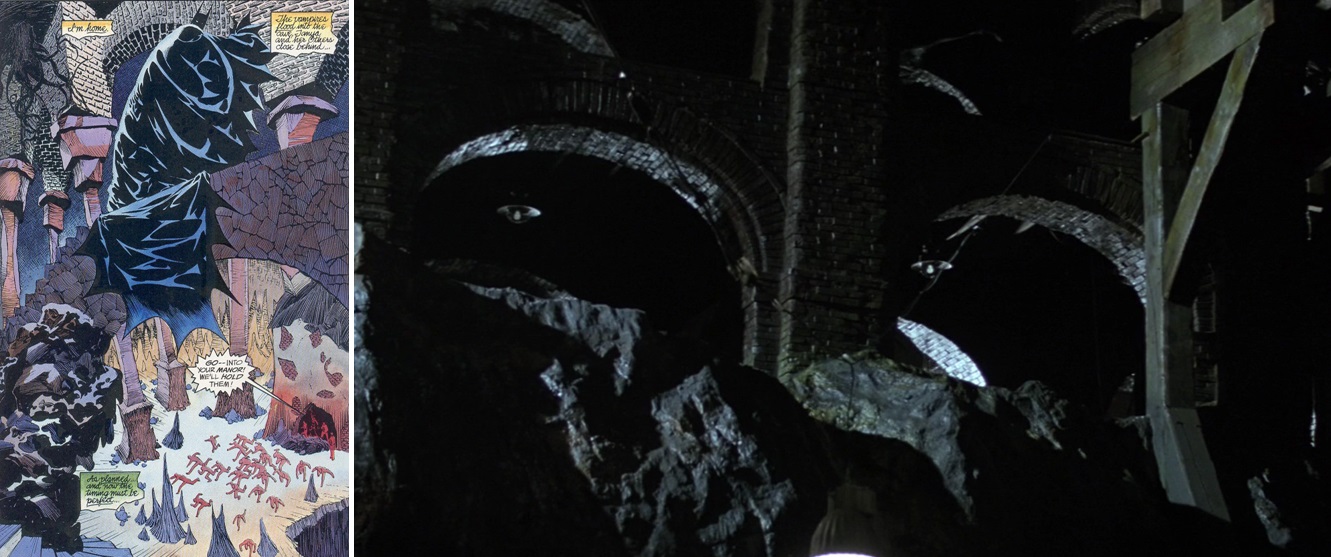
While they are inspecting the cave, Alfred mentions to Bruce that his ancestors were involved in helping slaves escape to the north via the underground railroad. In ‘Wayne Manor: Anatomy of a Murder’ (Shadow of the Bat Vol 1 #45, December 1995) Bruce researches his ancestors involvement with the underground railroad during the American Civil War. Flashback scenes in this story show his family smuggling escaped slaves through the caves beneath Wayne Manor, much the way Alfred describes them doing in the movie.

Bruce makes a trip to Wayne Enterprises after deciding to take a greater interest in his family's business. There he has a meeting with Wayne Enterprises CEO William Earle, played by Rutger Hauer. Earle was an original character created for the film. However he’s somewhat similar to the character of Jordan Pryce from the animated film Batman Beyond: Return of the Joker (2000) as well as Charles Palantine in Tim McCanlies's unproduced pilot for Bruce Wayne in 1999. All three characters were smarmy CEO’s running Bruce’s company in his absence, and all covertly opposed Bruce retaking control of his family business while outwardly pretending to support him.
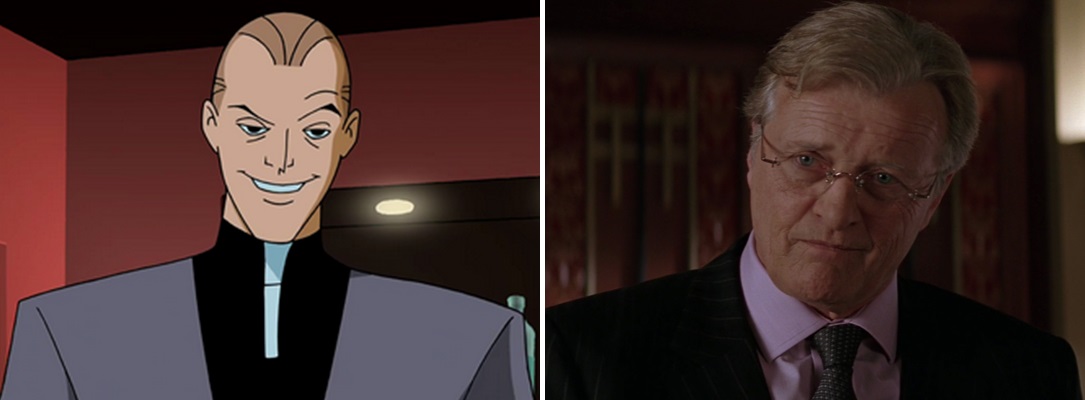
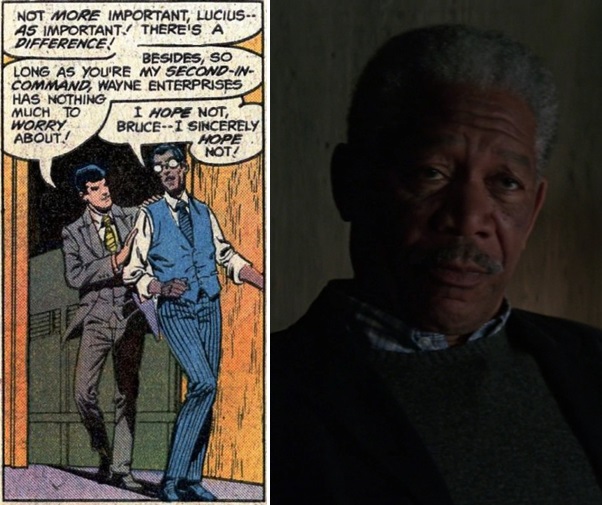
Bruce then meets Lucius Fox, a long-time employee who knows the ins and outs of the company better than anyone. Lucius first appeared in 'Dark Messenger of Mercy' (Batman Vol 1 #307, January 1979), where he served as Bruce's second-in-command at the Wayne Foundation. In both the comics and the movie, he acts as CEO in charge of the company when Bruce is too busy to run it himself.
Lucius supplies Bruce with much of his equipment in the film, including the Tumbler. It's worth noting that the Pre-Crisis Batman didn't construct most of his own equipment either. He maintained and repaired a lot of it, but many of his tools were originally made for him by other people.
- The Golden Age Batman's original costume was created by a tailor named Horton (Secret Origins Vol 2 #6, September 1986), while the Silver Age Batman's outfits were manufactured by Sam Tweed, aka the Masquerader (Detective Comics Vol 1 #390, August 1969).
- An Australian named Lee Collins built the first batarang for him as a gift and taught him how to use it (Detective Comics Vol 1 #244, June 1957).
- His Batmobiles were made for him by stuntman Jack Edison (The Untold Legend of the Batman).
- The first Batboat was a gift from Scotland Yard (Detective Comics Vol 1 #110, April 1946).
So this aspect of the film certainly has precedents in the source material. Meanwhile Fox also supplies Bruce with much of his equipment in the more recent comics, as well as acting as a go-to consultant whenever Batman needs advice concerning hi-tech hardware. The idea of Batman’s arsenal being derived from Wayne Enterprises technology dates back to 'Choice of Weapons' (Detective Comics Vol 1 #0, October 1994).
One of Batman's most prominent gadgets in the film is his cape-glider made from memory cloth. Although this originated in the movie, there are numerous instances of Batman using his cape as a glider in the Pre-Crisis comics. However the use of the glider in this film is most likely a nod to Batman: Year One.
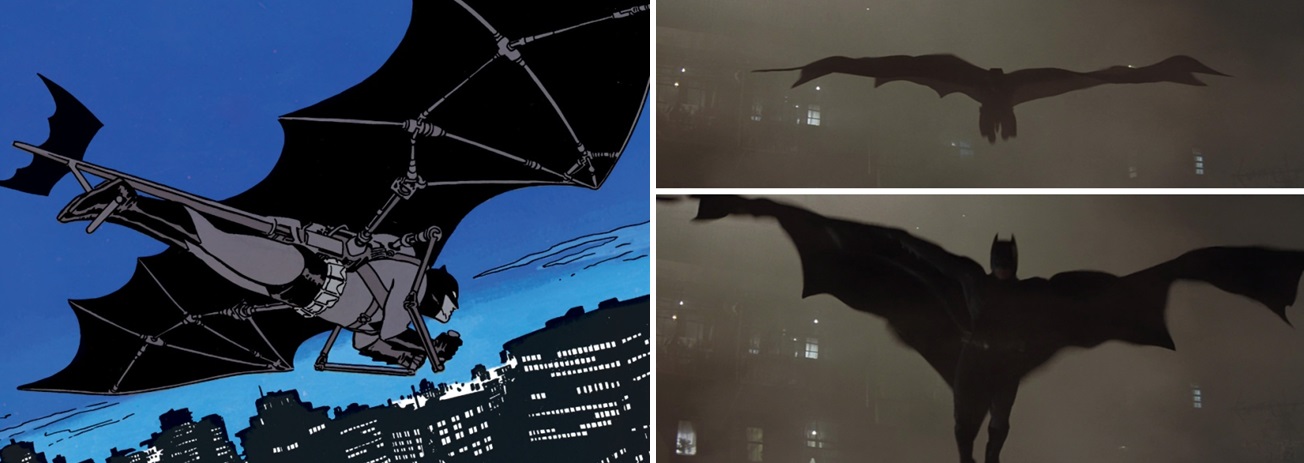
The idea of having Batman's cape transform into a glider may have been influenced by Tim Burton's Batman Returns (1992). Since Batman Begins was released, the cape glider has featured in both the comics and the Arkham videogame series.
Batman’s costume displays several design features that distinguish it from the previous movie costumes: namely shorter ears on the cowl, an all-black chest emblem lacking the yellow oval of earlier designs, and a utility belt sporting pouches instead of capsules. These are the same characteristics that distinguished the Batman: Year One costume from the Bronze Age design that preceded it. In this sense, the Batman Begins costume is essentially a black armoured version of the Year One suit.
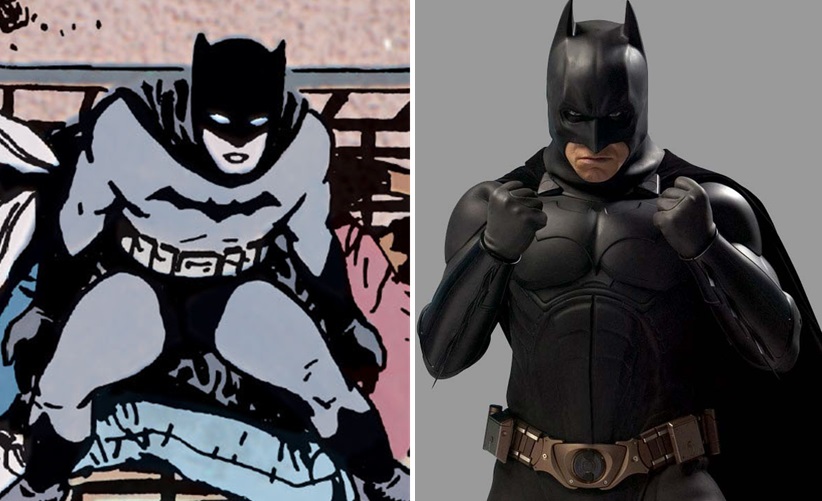
Batman's batarangs in this film are more like shurikens than boomerangs. He's been shown to wield similarly-shaped batarangs in the comics, as illustrated by this example from Batman: Prey (1990-91).
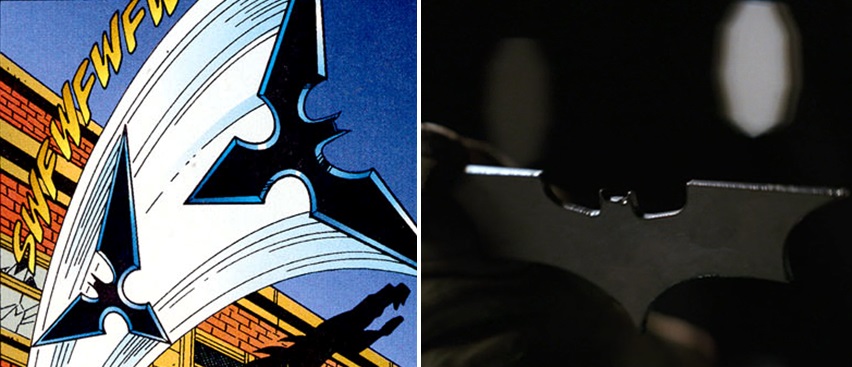
The scene where Bruce is crafting them is similar to a scene in ‘Dark Angel I: The Fall (Batman Vol 1 #500, October 1983) where the Jean-Paul Valley Batman fashions his own weapons.
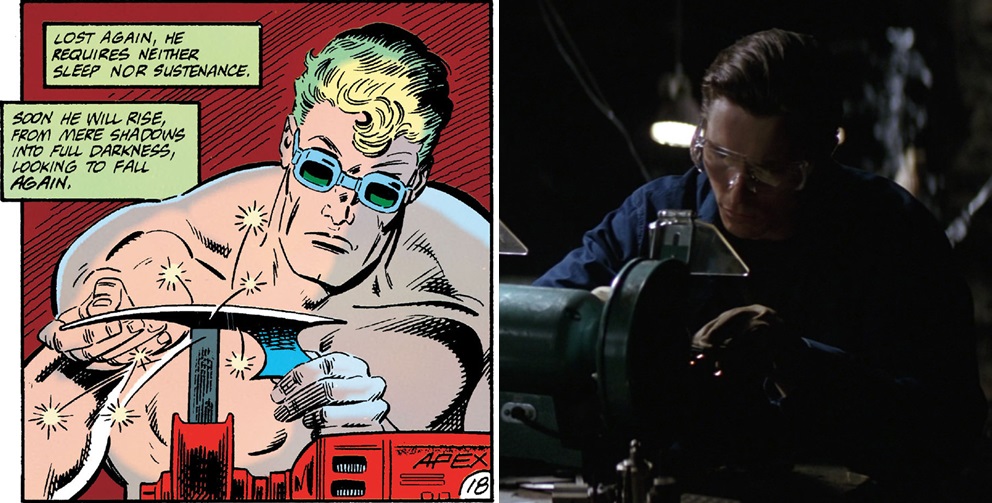
Batman speaks with a distinctive growl in this film. He's also described as growling to intimidate his enemies in Year One.
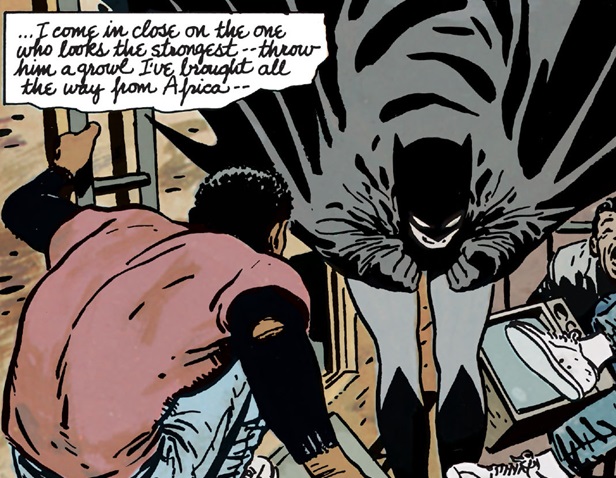
Not a comic reference per se, but Batman’s first line in costume is his “I’m Batman” catchphrase. The Michael Keaton Batman spoke the same line during his first scene in Tim Burton’s Batman (1989), and the context behind its use in both films is very similar.
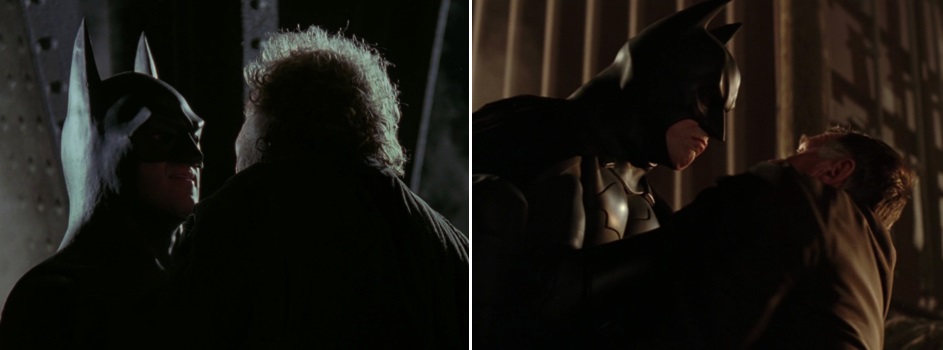
The scene at the docks ends with Batman strapping Falcone to a searchlight, thereby alerting the police to his whereabouts and inadvertently creating the first Bat-Signal. This is not the first time someone has been strapped to the Bat-Signal, as Batman found himself in a similar predicament in 'Signalman Steals the Spotlight!' (Detective Comics Vol 1 #466, December 1976).
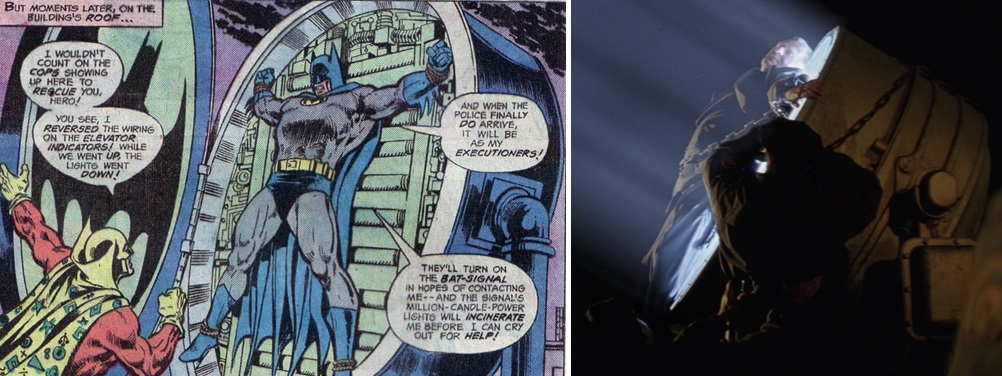
Falcone was one of the first criminals Batman targeted in Year One. While he ties him to a searchlight in the film, he ties him up naked in the comic.
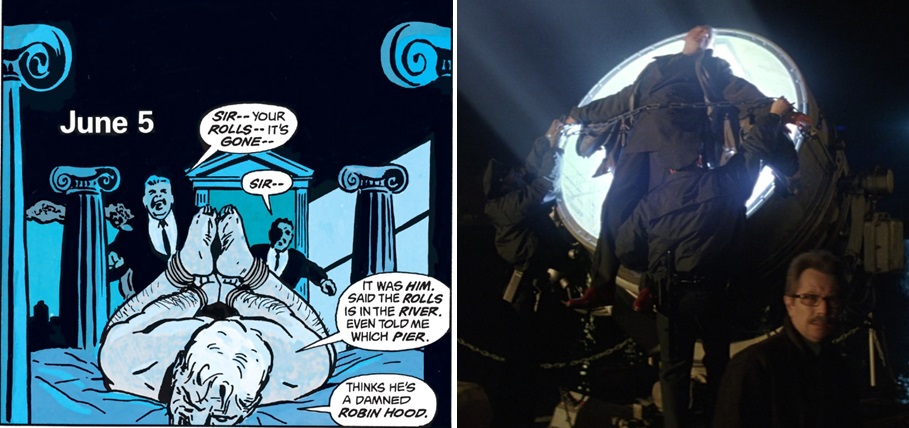
Bruce doing his morning push-ups while chatting with Alfred is straight out of Year One.

As in Year One, Batman's vigilante activities soon attract the attentions of the police.

Meanwhile Bruce Wayne deflects suspicion by behaving like a boorish playboy in a hotel restaurant. Bruce affects a similar playboy persona in many of the comics, though this was the first time he was shown to do so in any of the movies. He resumes the act during a later scene where he expels the guests from his birthday party by going on a drunken rant.
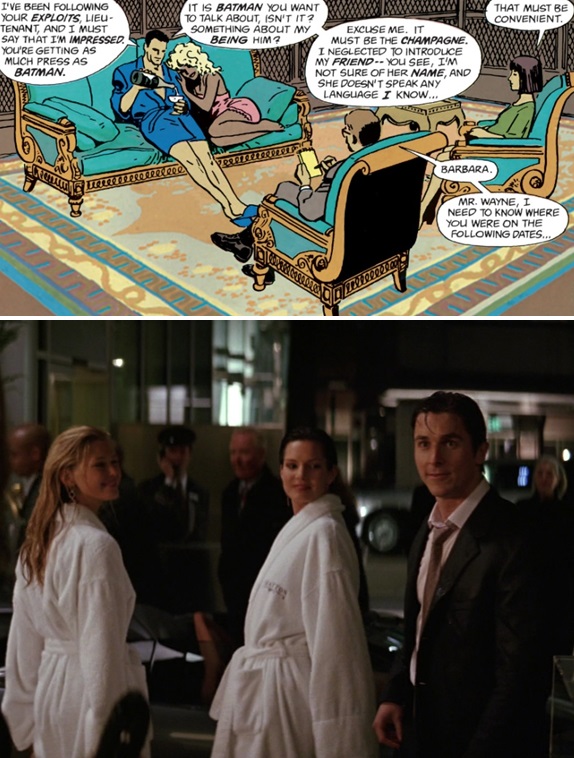
At one point in the film Batman converses with Gordon on a fire escape outside the latter's apartment. This scene is adapted from Batman: Prey (1990-91). Note that Batman tells Gordon there's no need to thank him, similar to his final line at the end of the film.
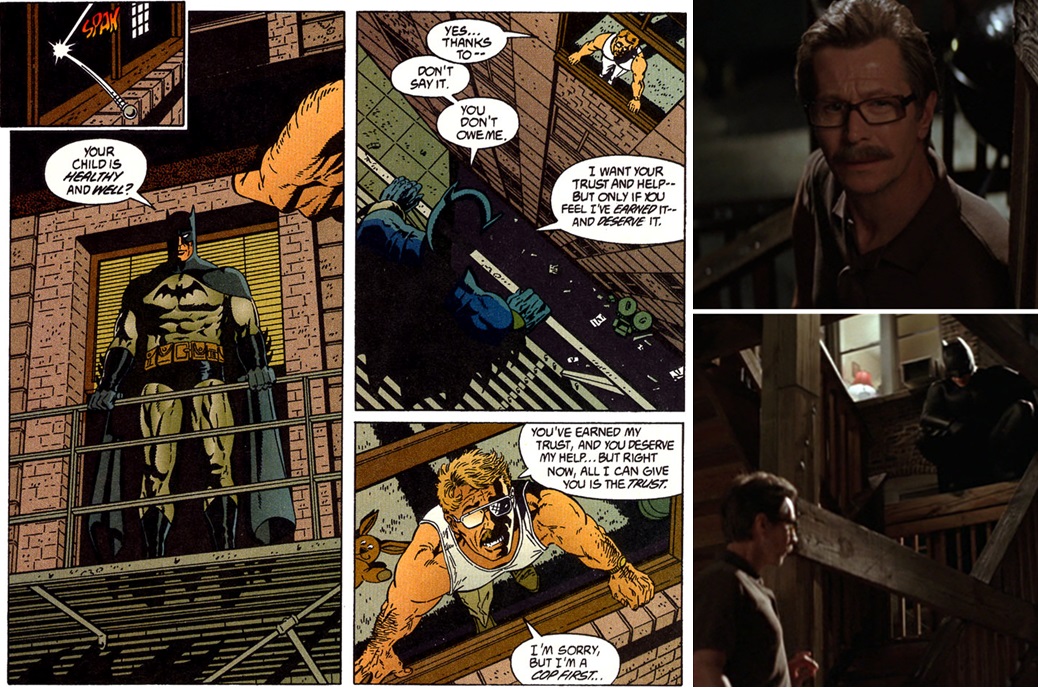
Gordon looks away for a second, then turns back to discover Batman has vanished. This is a long-running gag in the comics and is referenced several more times throughout Nolan's trilogy.
The subplot about the League stealing a Wayne Tech invention recalls a similar plot point in Batman: The Movie (1966). In both films the villains acquire an experimental device designed to evaporate water, stealing it from a yacht mid-transit and assigning it a pivotal role in their master plan.
Another major villain in the film is Jonathan Crane, aka the Scarecrow, played by Cillian Murphy. Crane first appeared in the comics in ‘The Riddle of the Human Scarecrow’ (World’s Finest Vol 1 #3, September 1941). Murphy strongly resembles the character as he was originally drawn by artist Jerry Robinson.
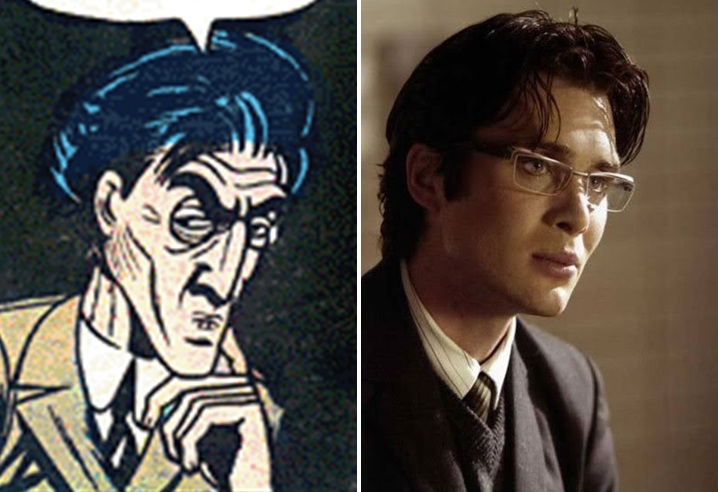
Like his comic book counterpart, the movie version wears a mask resembling a burlap sack and wields an hallucinogenic fear toxin as his primary weapon.
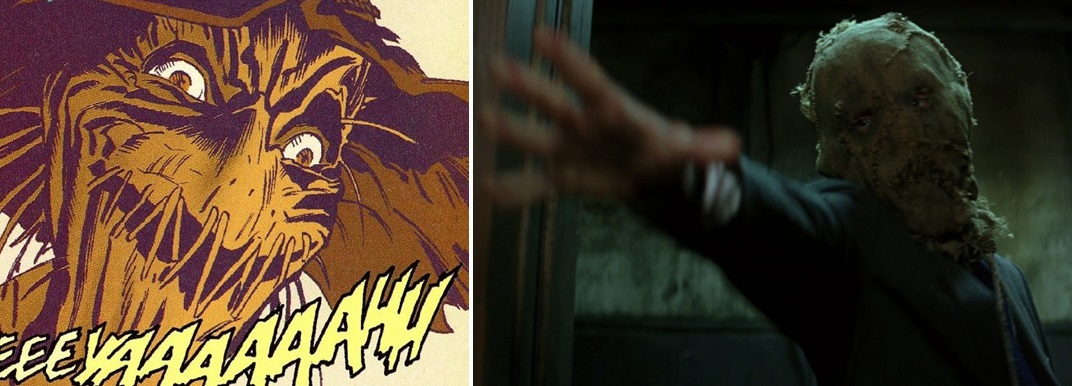
The first time we see Crane in the movie he is in court providing a psychological evaluation on Victor Zsasz (or "Mr. Zsaz," as spelled in the movie's end credits). Zsaz, played here by Tim Booth, is a knife-wielding psychopath who carves tallies into his flesh to keep count of how many victims he’s killed. He first appeared in the comics in ‘The Last Arkham: Part I’ (Shadow of the Bat Vol 1 #1, June 1992). In the film, Zsaz's tally marks are less obvious but can be seen on his neck during close-up shots.
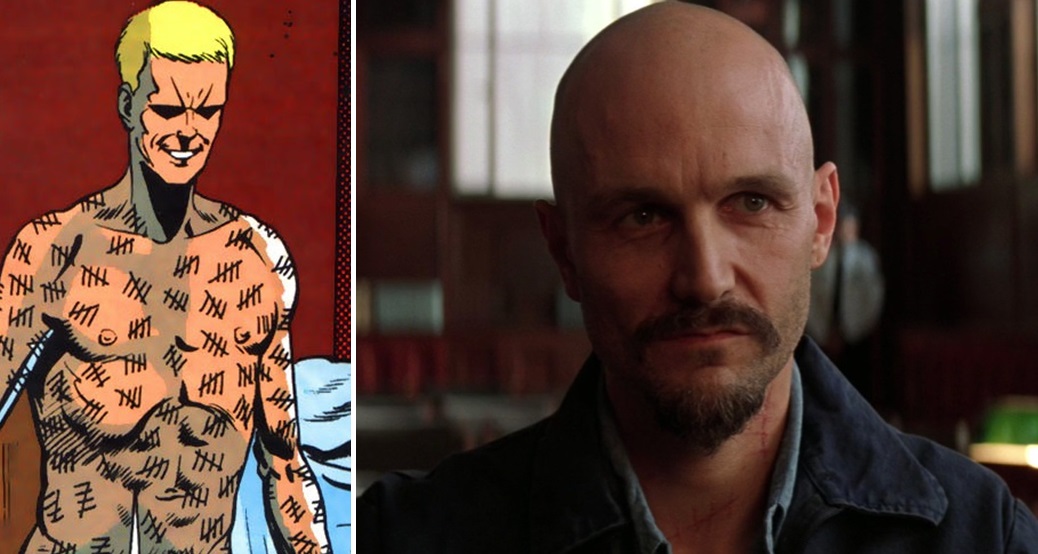
Crane helps send Falcone's men to Arkham Asylum in exchange for the mobster's help in importing the hallucinogenic drugs he requires to assist Ra's al Ghul. In The Long Halloween, Falcone and Scarecrow form a very brief, shaky alliance. But unlike his cinematic counterpart, the Falcone in the comic is aware of his ally's costumed persona.
The scene where Batman hangs Flass upside down from a rooftop while he interrogates him is similar to a scene from the ‘Fears’ chapter of Batman: Haunted Knight (1996), which was originally published in Legends of the Dark Knight: Halloween Special Vol 1 #1 (December 1993). In both stories, the topic of the interrogation concerns Scarecrow’s criminal activities.
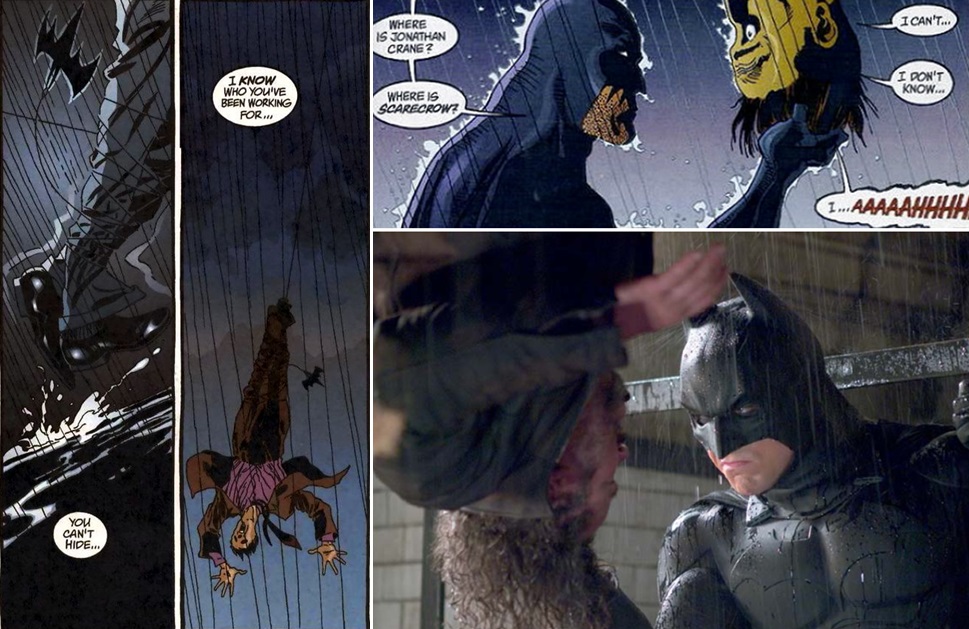
The comic book Flass was traumatized in Year One after Batman thwarted an illegal drug deal he was supervising. The movie Flass is similarly shaken after his encounter with the Dark Knight.
The idea of Scarecrow hiding the chemical components of his fear toxin inside a shipment of stuffed toys is lifted from Batman: Dark Victory (1999-2000), the sequel to The Long Halloween.
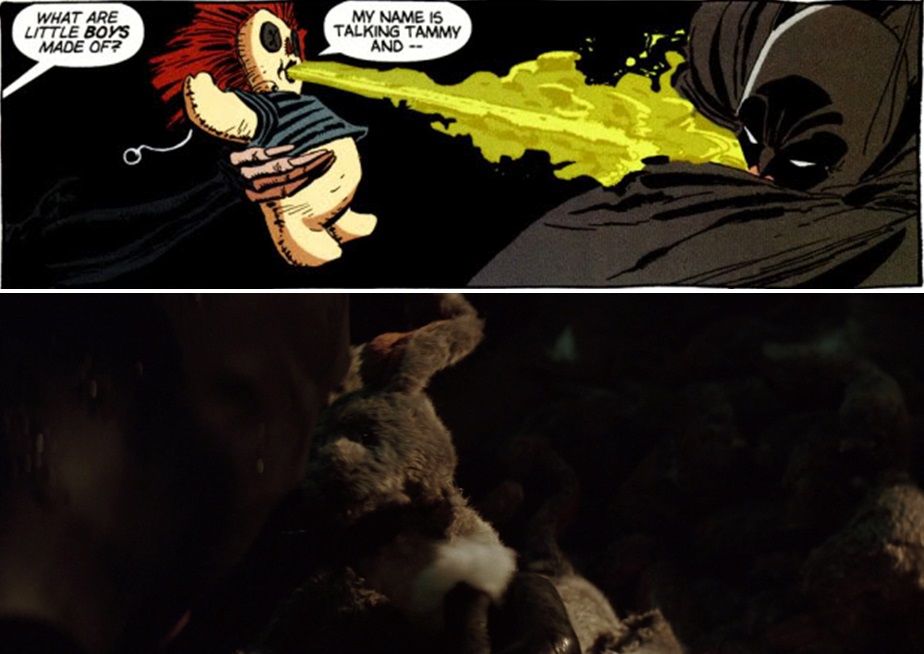
Batman is exposed to the hallucinogenic fear toxin during his first battle with Scarecrow. This causes him to relive the horror of the night his parents were killed, just like he did when Scarecrow gassed him in The Long Halloween.
It falls upon Alfred to administer the antidote and nurse him back to health. This also happened in Batman: Haunted Knight.
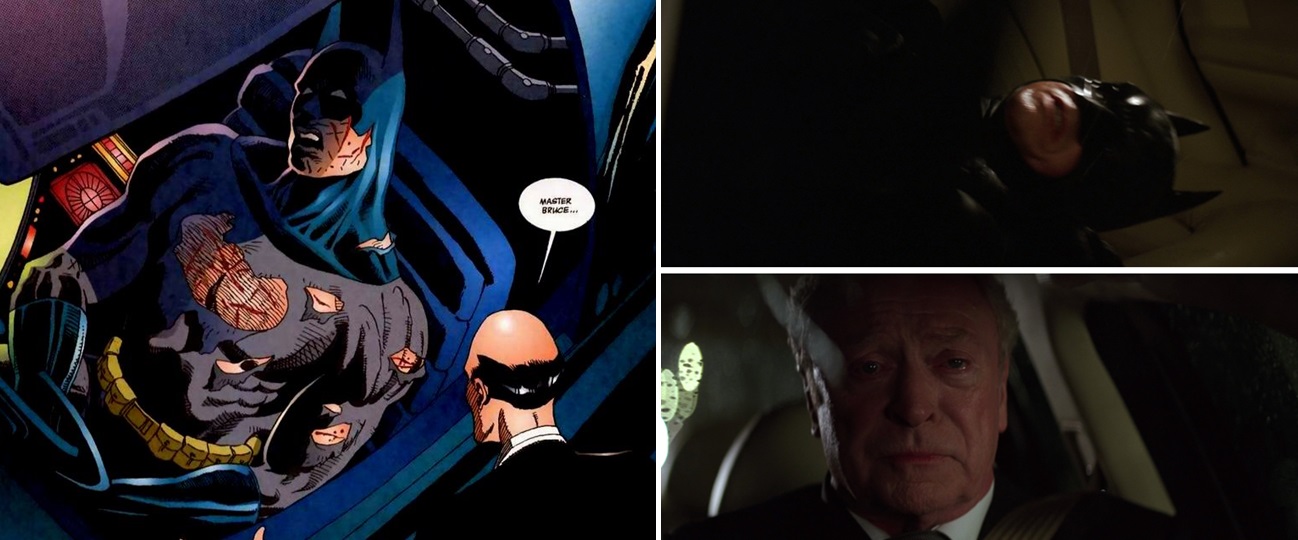
Alfred maintains a vigil by his bedside while Bruce suffers through fear-induced hallucinations.

Bruce is soon back on his feet and ready for action. He descends to the Batcave using an elevator hidden behind a sliding bookcase in Wayne Manor. This might be an allusion to the sixties TV show in which the Batpoles were concealed behind a similar article of furniture.
In the earlier Batman films, Bruce was shown to store his Batsuit in a vault. But in Batman Begins he stores it within a simple closet.
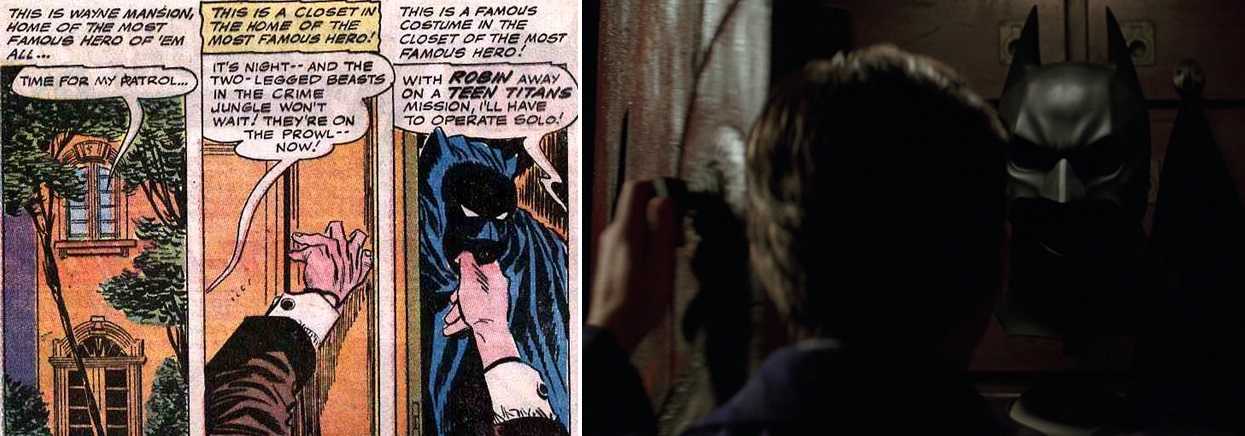
When Rachel is exposed to Scarecrow’s fear gas, she hallucinates that maggots and bats are crawling out of his mask. A similar hallucination occurred in Batman: Haunted Knight where some policemen saw snakes crawling out of the eyeholes in Crane's mask.
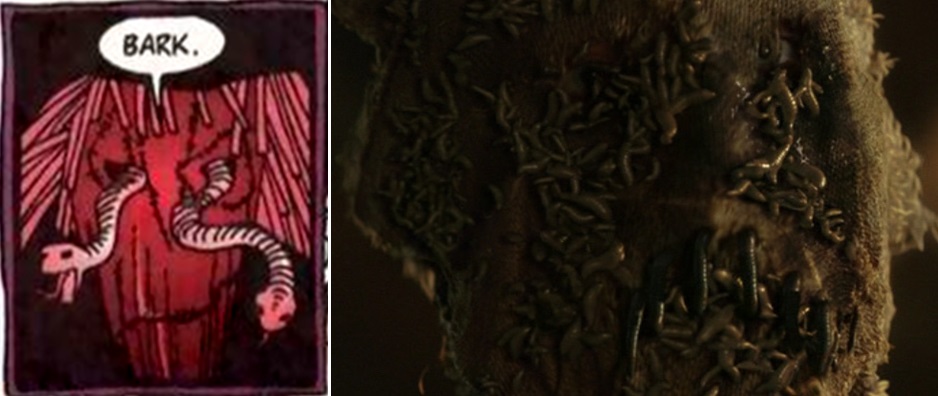
Batman rescues Rachel from Scarecrow’s men and exposes Crane to his own fear gas. Scarecrow’s line, “Dr. Crane isn’t here right now, but if you’d like to make an appointment...” is adapted from Batman: Haunted Knight.
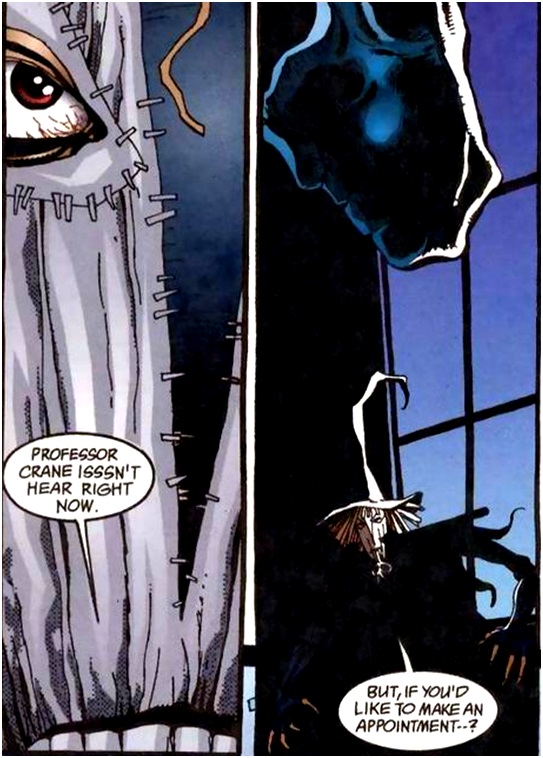
The scene where the police surround Arkham with Batman trapped inside is adapted from Year One. Only in the comic they had him cornered in a condemned tenement, not an asylum.
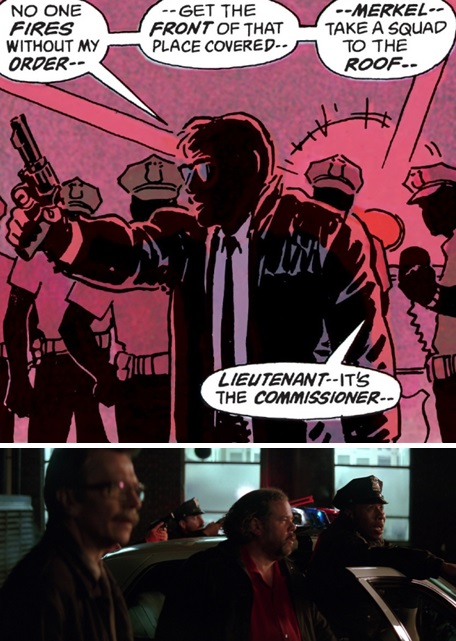
The GCPD sends a SWAT team in after him.
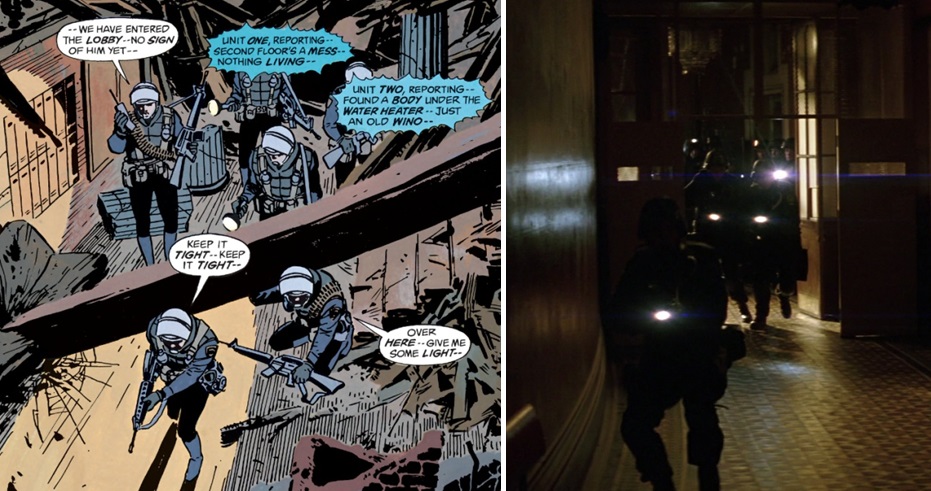
Batman activates a sonic device concealed in the heel of his boot.
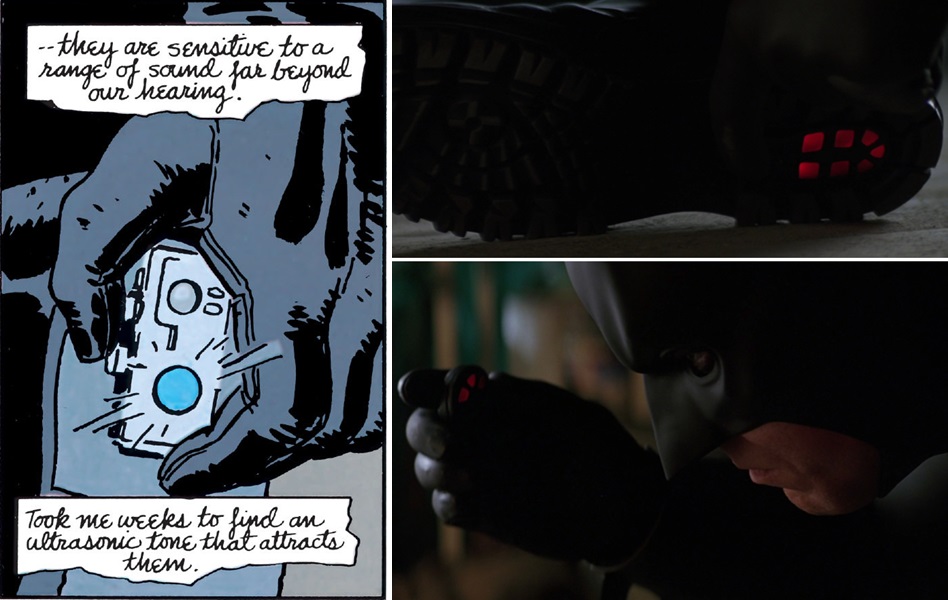
And this summons a swarm of bats to provide a diversion while he makes his escape. Gordon himself moves the wounded Merkel to safety in Year One, while he carries Rachel Dawes out of harm's way in Batman Begins.
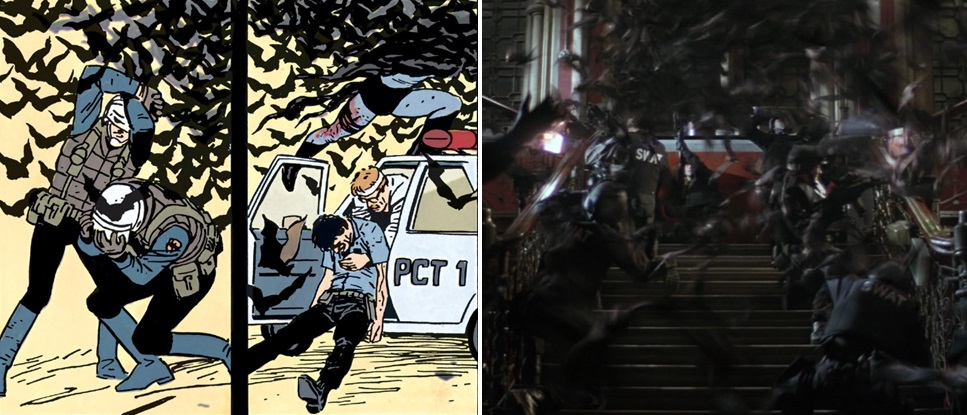
Batman hurls miniature explosives to blast his way through the locked doors of Arkham.

Batman then takes Rachel back to the Batcave using the Tumbler, the Nolanverse incarnation of the Batmobile. The tank-like design of the Tumbler was inspired by the Batmobile from The Dark Knight Returns. Earlier precedents for this type of design date back to the Bat-Tank from ‘The New-Model Batman’ (Detective Comics Vo 1 #236, October 1956).
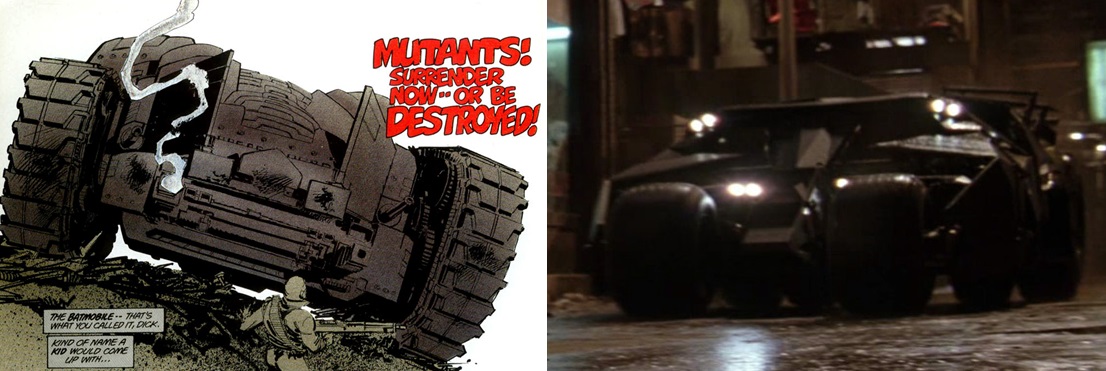
The Tumbler features an afterburner which ignites whenever it accelerates into jump mode. Despite its size, it’s capable of leaping across short distances. The Batmobile in the comics has been shown to make similar jumps, as demonstrated by this example from ‘The Batmobile of 1950’ (Detective Comics Vol 1 #156, February 1950).

When Bruce returns to Wayne Manor he finds Ducard waiting for him. Only now does he finally realise his former mentor is the true Ra’s al Ghul. After Bruce and Ducard parted ways in Blind Justice, they remained estranged until the latter showed up at Wayne Manor and confronted his protégé over his secret identity as Batman. Ra’s al Ghul's appearance at Wayne’s party also reflects a plot point in Batman: Shaman where Tom Woodley shows up at Wayne Manor seeking revenge against Bruce. In both comics, as well as in the movie, we see characters Bruce encountered during his pre-Batman wanderings appearing at his home in the hopes of settling a score over a past grievance.
As in the comics, Ra's deduces that Bruce and Batman are one and the same. He announces his discovery to Bruce while visiting him at his residence. In the film this discussion occurs in Wayne Manor, while in 'Daughter of the Demon' it happens in the Batcave.
There are numerous possible comic influences for the burning of Wayne Manor. In Mark Waid and Alex Ross’ Kingdom Come (1996) Wayne Manor had been burned down by the combined forces of Two-Face and Bane. Meanwhile Ra’s and the League of Shadows attacked Wayne Manor in Mike W. Barr and Tim Grindberg’s Batman: Bride of the Demon (1990). The burning down of Wayne Manor may also have been inspired by the final chapter of The Dark Knight Returns.
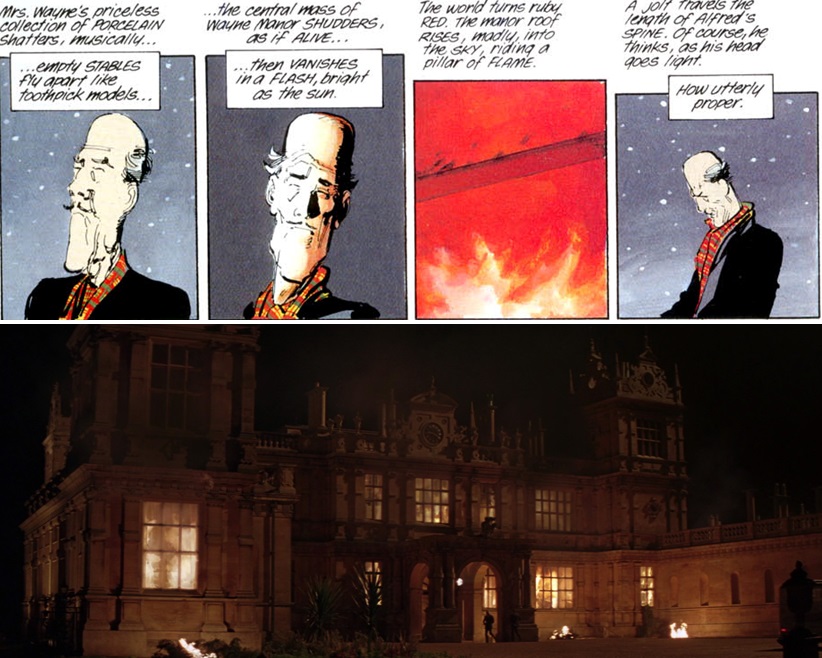
After setting fire to Bruce's home, the League of Shadows then breaks into Arkham and unleashes the inmates upon Gotham. The Society of Shadows (the Batman: The Animated Series equivalent of the League of Assassins) also broke into Arkham in the comic story 'No Asylum' (Batman Adventures Vol 2 #1, June 2003), although they didn't release the inmate. However Ra’s did orchestrate a mass breakout from Arkham in ‘Resurrection Night!’ (Batman Vol 1 #400, October 1986).
Scarecrow's narrative, involving his capture and subsequent escape, also echo Haunted Knight. In both stories Batman apprehends Scarecrow before attending a party at Wayne Manor, only for Crane to escape custody later that same night.
Ra’s al Ghul's plan to unleash a poison gas upon the people of Gotham recalls his master plan in ‘The Messiah of the Crimson Sun’ (Batman Annual Vol 1 #8, 1982). In the comic Ra’s planned to use a light beam directed from a satellite to trigger a specific poison he’d previously hidden in Gotham’s water supply. The poison was harmless on its own but would become lethal upon reacting with the beam. In the film he uses a microwave emitter to turn the inert fear toxin he’s hidden in the water supply into an active gas.

The gasmasks worn by members of the League of Shadows resemble those worn by Ra’s al Ghul’s henchmen in ‘Swamp Sinister’ (Batman Vol 1 #235, September 1971).
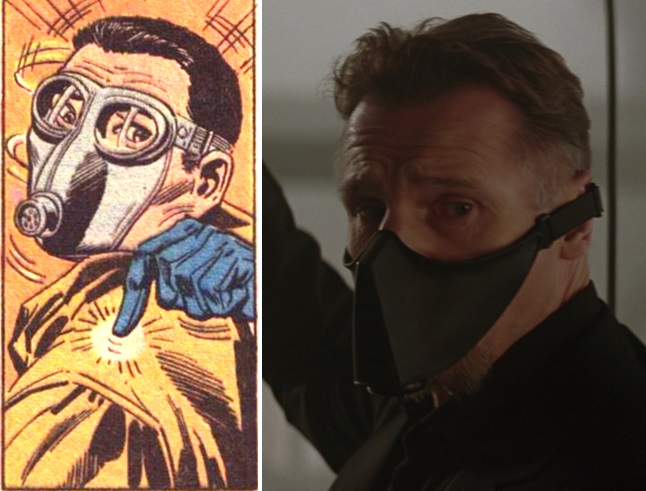
The half mask look is also similar to what Ra's wore in 'I Now Pronounce You Batman and Wife' (DC Special Series Vol 1. #15, June 1978).
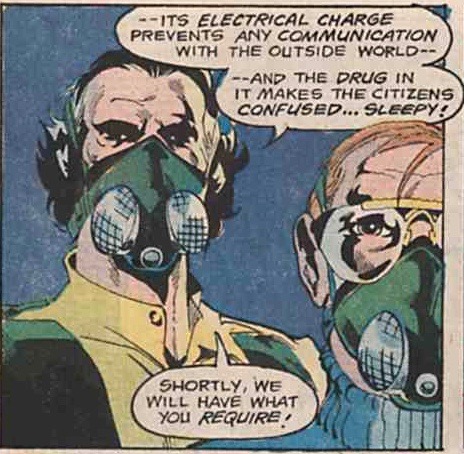
Once free of Arkham, Scarecrow takes to the streets on horseback. He also rode a horse after escaping from Arkham in The Long Halloween.
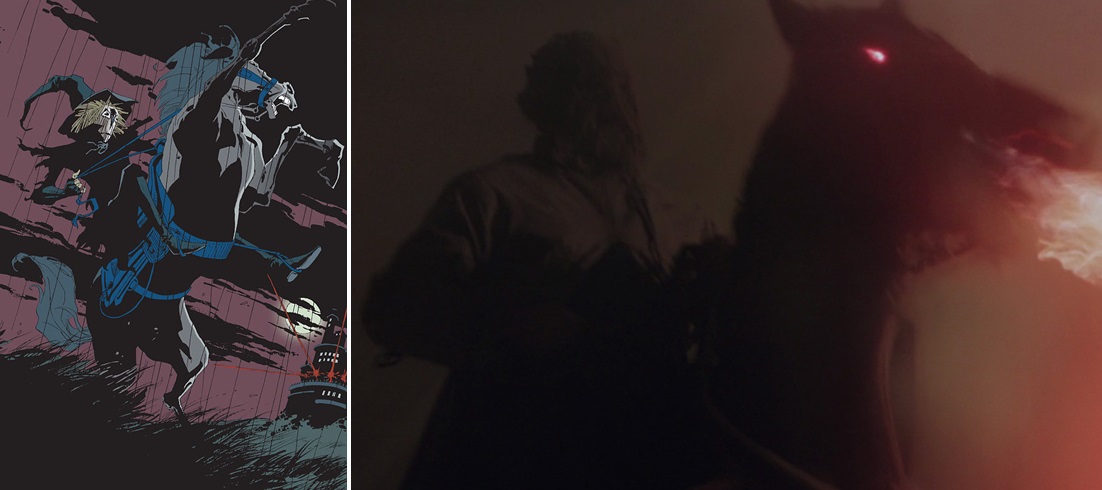
The influence of his fear toxin gives Scarecrow the appearance of having flames erupt from his mask. This is another image lifted from Batman: Haunted Knight.
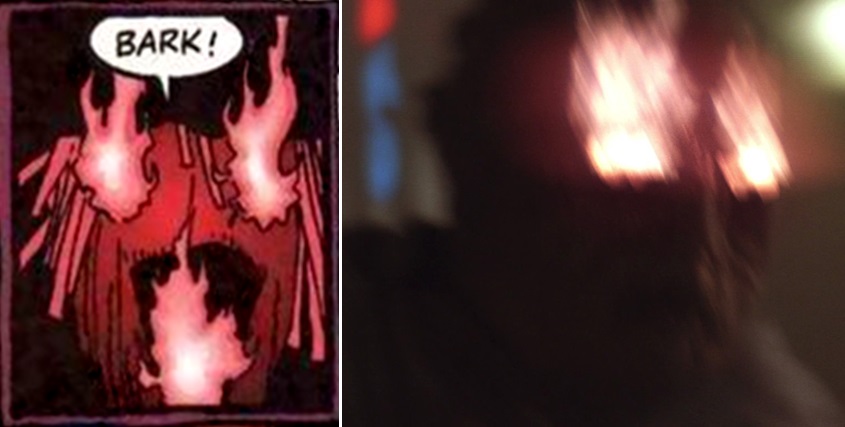
One of the special features on the Batman Begins DVD makes the following visual comparison.
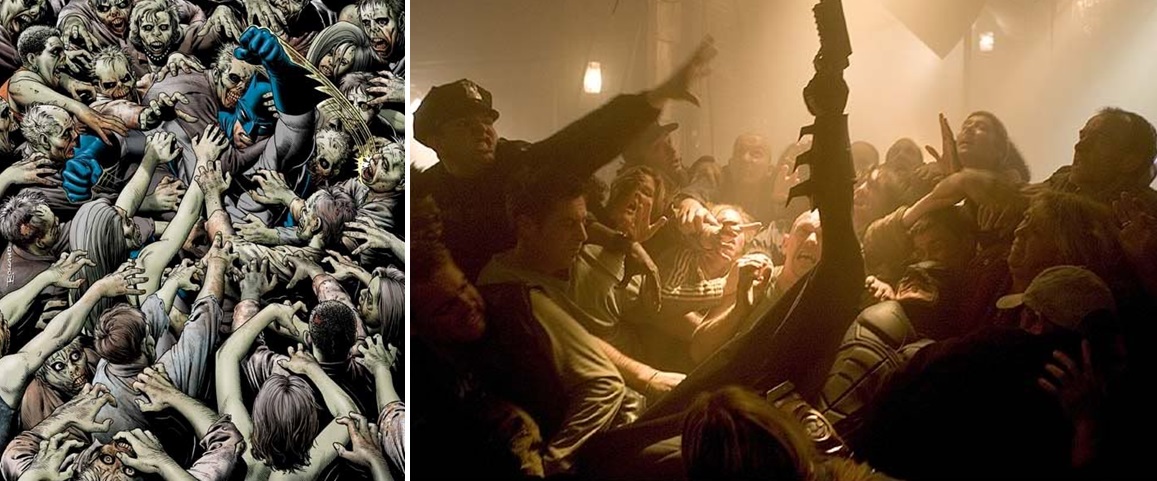
The climatic fight between Batman and Ra's occurs on the speeding monorail. This is very similar to the showdown between the Jean-Paul Valley Batman and Bane at the end of 'Dark Angel II: The Descent' (Batman Vol 1 #500, October 1993), which was part of the Knightfall story arc. In both battles the villain boards an elevated train. Batman then enters the vehicle as it speeds along the tracks, smashing his way in through one of the windows.
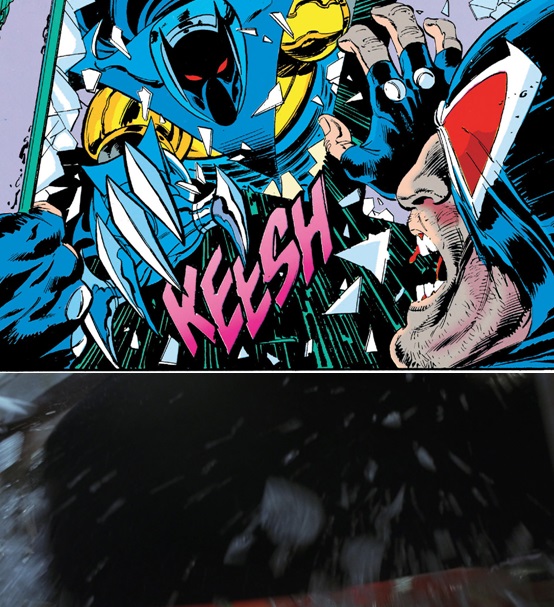
The two opponents do battle as the driverless train rockets along the track. At one point during the comic book fight, Batman smashes Bane’s head through one of the train’s windows. Ra’s does the same thing to Batman in the movie.
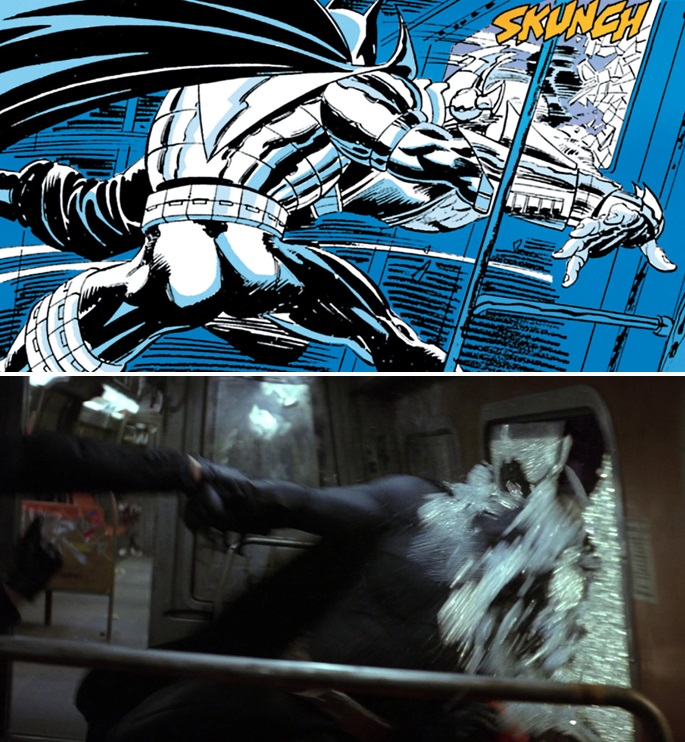
In both stories, the carriage playing venue to the battle is separated from the rest of the train by an explosive pellet. In the comic it's Robin who throws this, while in the movie it's Batman himself.

The train derails and crashes with the villain still inside. In the comic, Batman is also still inside the train when it crashes. But in the movie he escapes the vehicle beforehand.
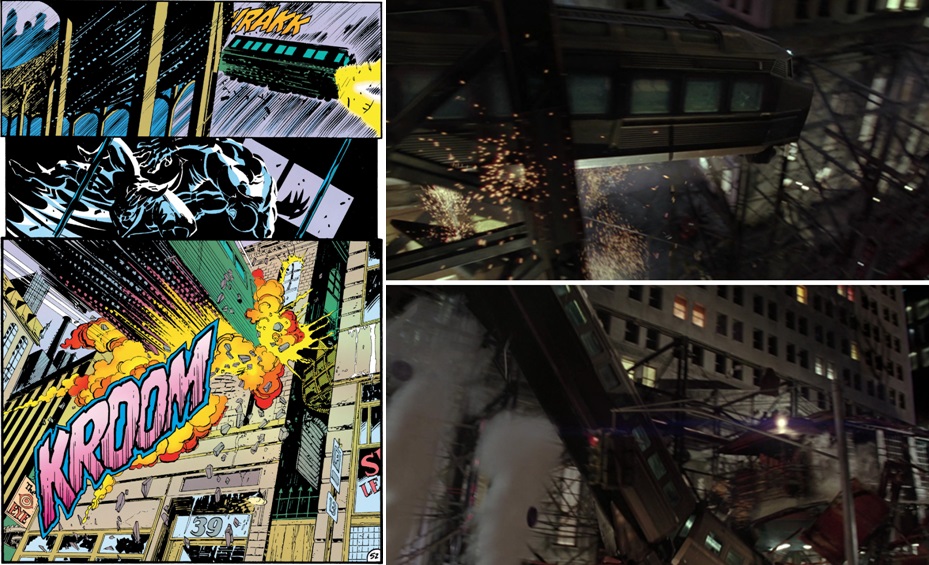
There’s some controversy amongst fans about Batman’s decision to leave Ra’s to die on the monorail, as this seems to contradict Batman’s moral code against killing. However it’s worth remembering that Batman has indulged similar lapses in his moral code in the comics on many occasions. In several stories he’s even tried to kill Ra’s al Ghul, including the aforementioned ‘The Messiah of the Crimson Sun’. At the end of that particular comic, Batman uses a remote control to steer Ra’s al Ghul’s escape pod into the lethal rays of the sun. You might argue that Batman knew Ra’s could regenerate using his Lazarus Pits, but in this particular instance Batman tried to kill Ra’s in space in such a way that would have resulted in the total incineration of his remains, making it impossible for his followers to revive him. To all intents and purposes, Batman consciously chose to kill Ra’s in this comic.
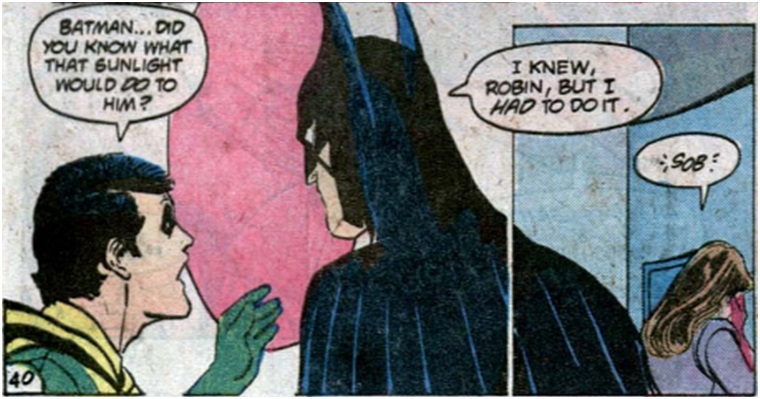
So while Batman's actions in the movie may seem inconsistent with his moral code, the inconsistency itself is nevertheless inherited from the source material.
Bruce regains control of Wayne Enterprises by purchasing enough stock to become a majority shareholder. He also appoints Lucius as his new CEO, just as he did in ‘The I of the Beholder’ (Detective Comics Vol 1 #511, February 1982).
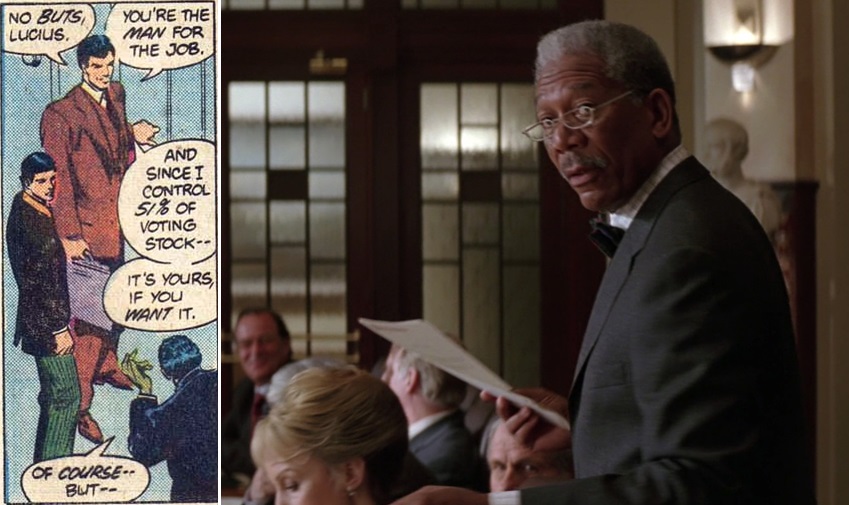
The final scene of the film sees Gordon summoning Batman for the first time with the Bat-Signal. This evokes a similar scene in Batman: Prey where Batman first responds to the Bat-Signal.
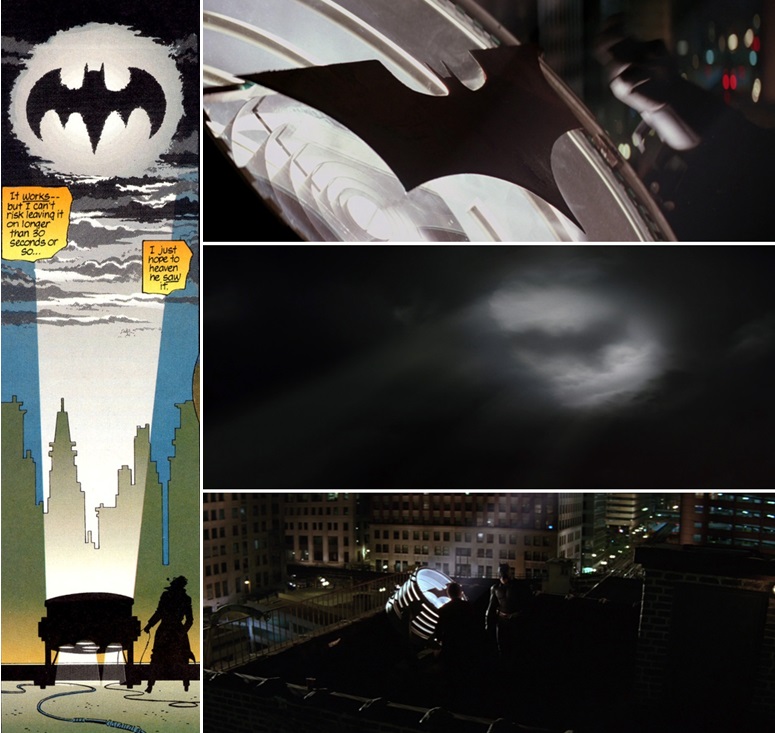
Gordon informs Batman of a new criminal in Gotham – one who marks his crimes by leaving a Joker playing card. The final scene of Year One ends on a similarly ominous coda.
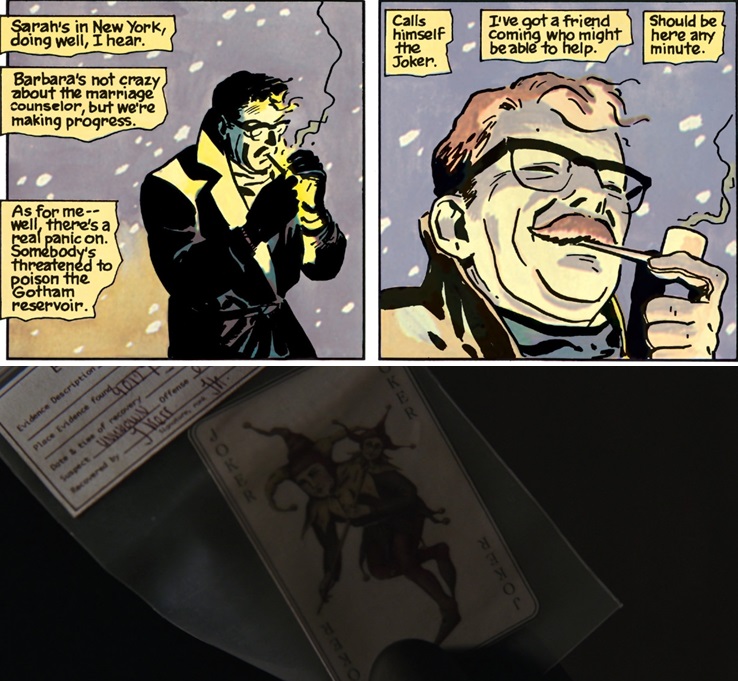
And that concludes this analysis of Batman Begins.
comments powered by Disqus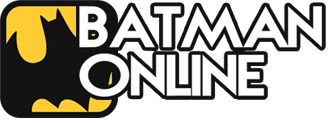
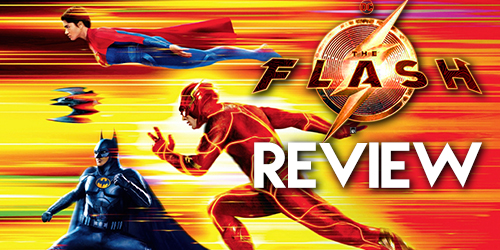
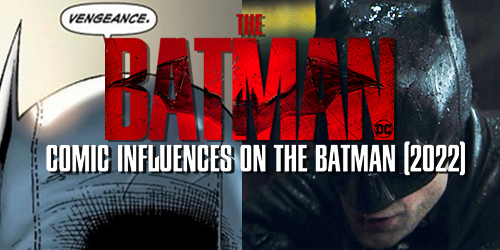
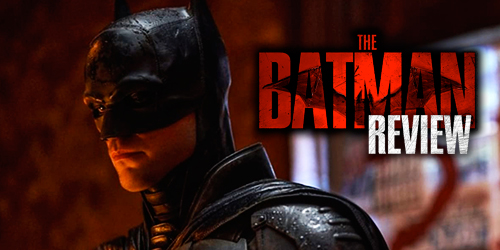

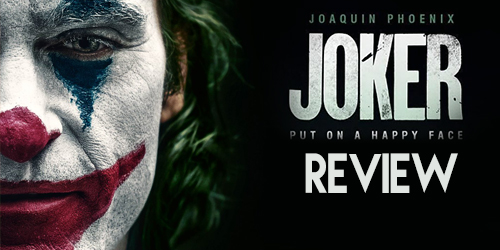
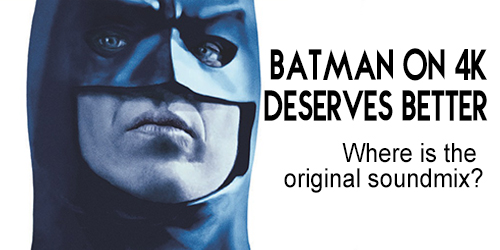
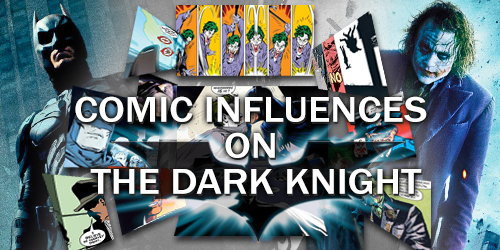

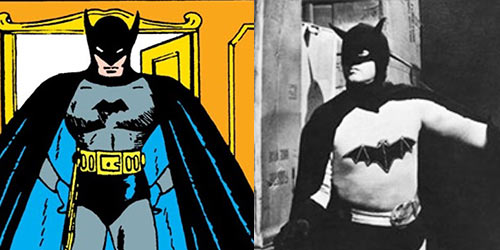
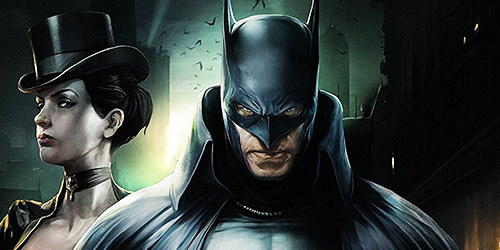
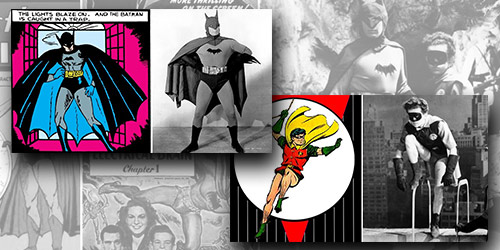
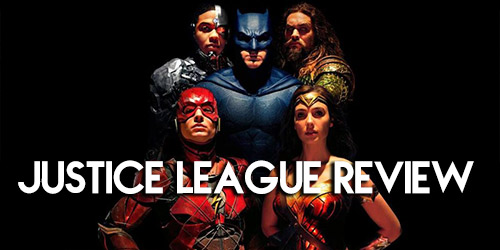
by The Joker
by Slash Man
by Silver Nemesis
by The Dark Knight
by Slash Man
by Slash Man
by The Joker
by Slash Man
by Gotham Knight
by Silver Nemesis